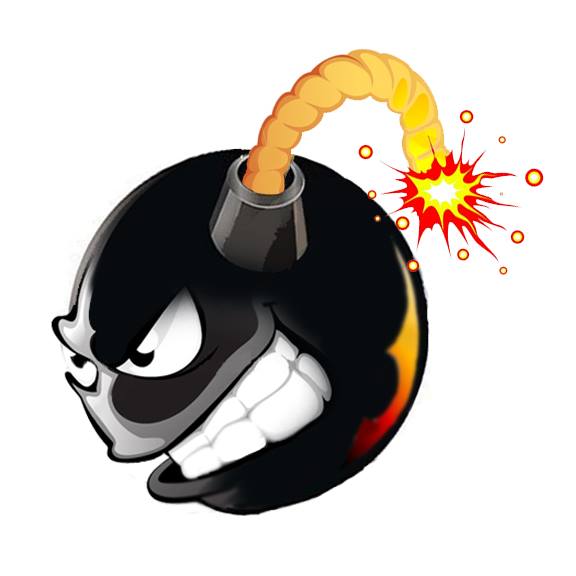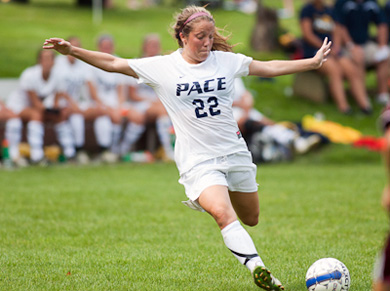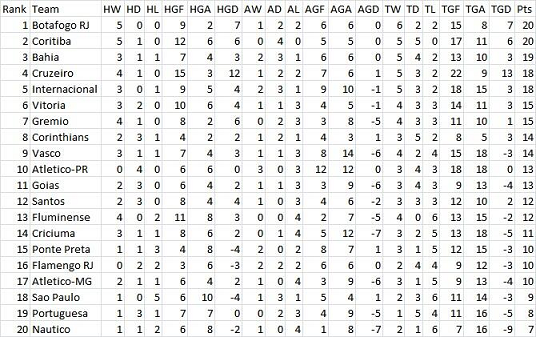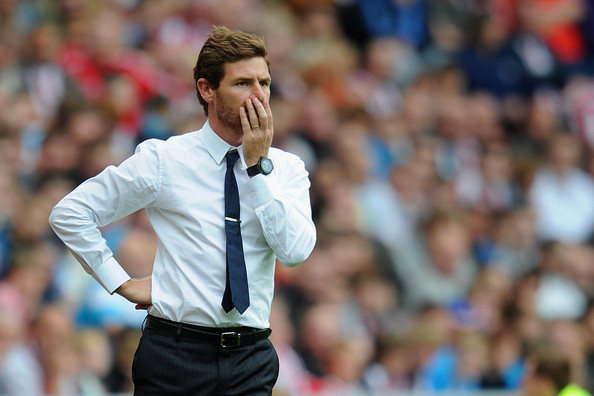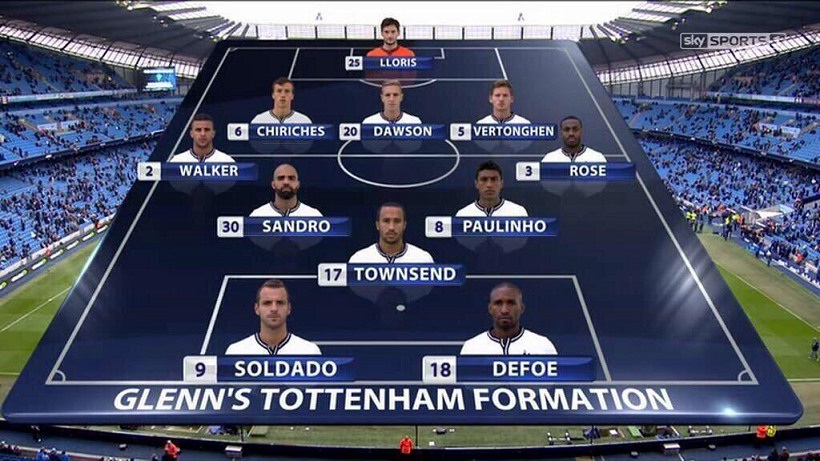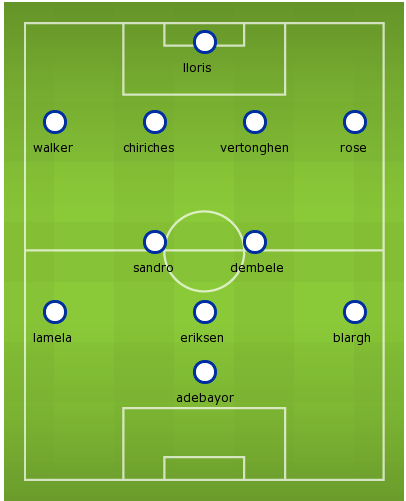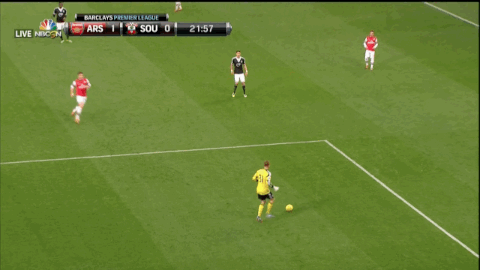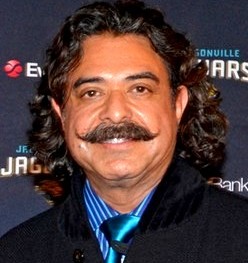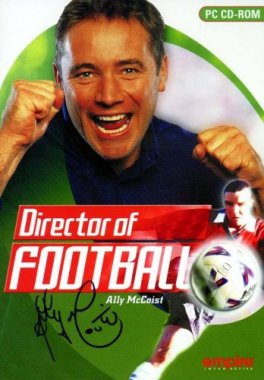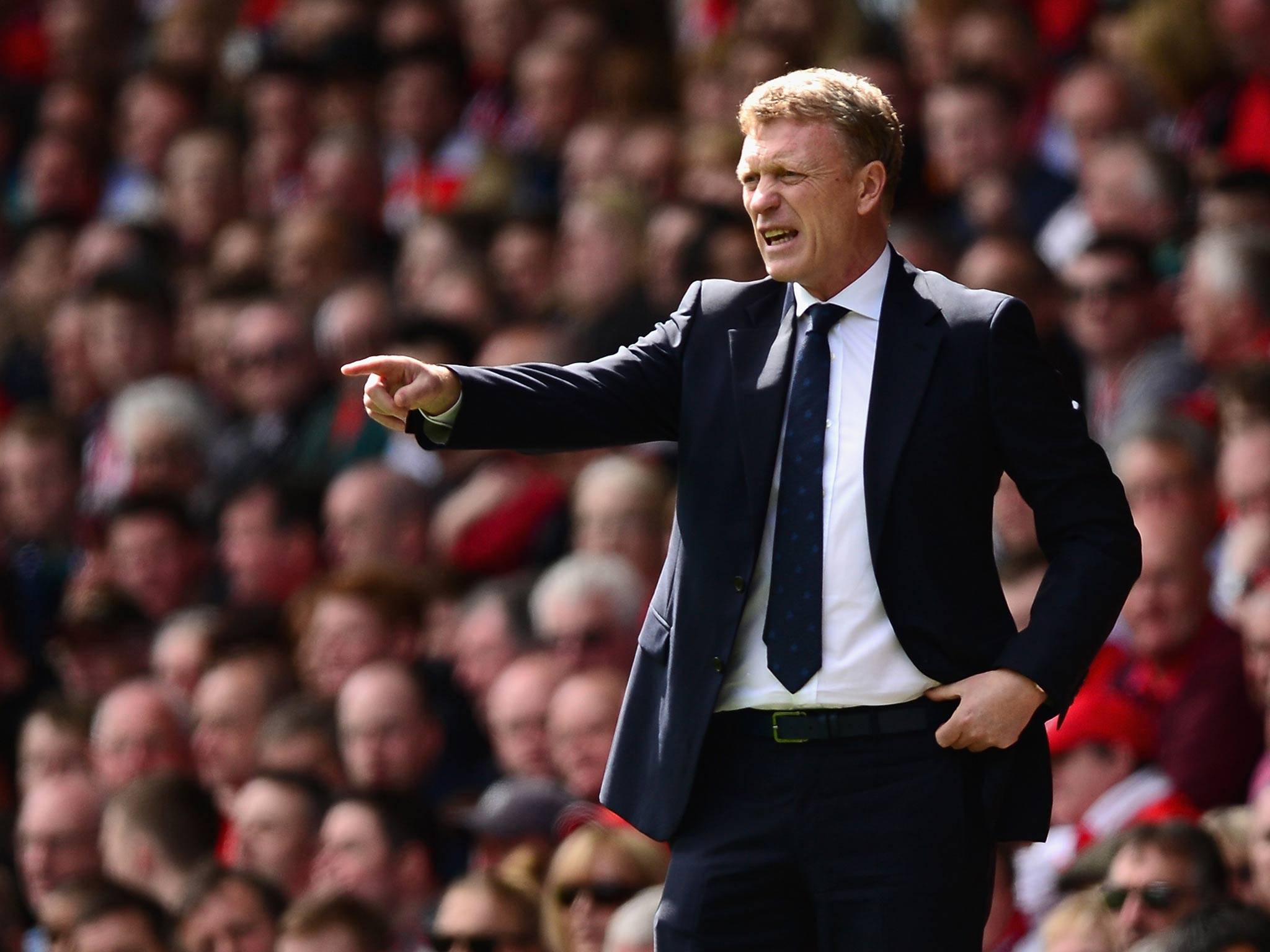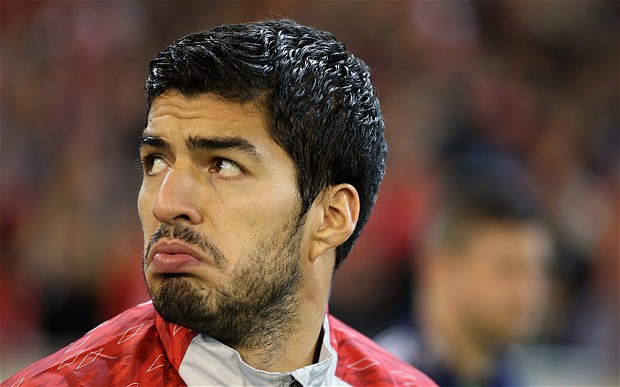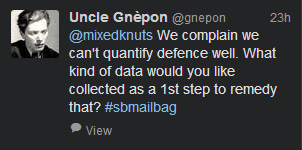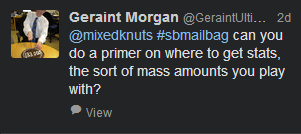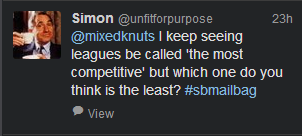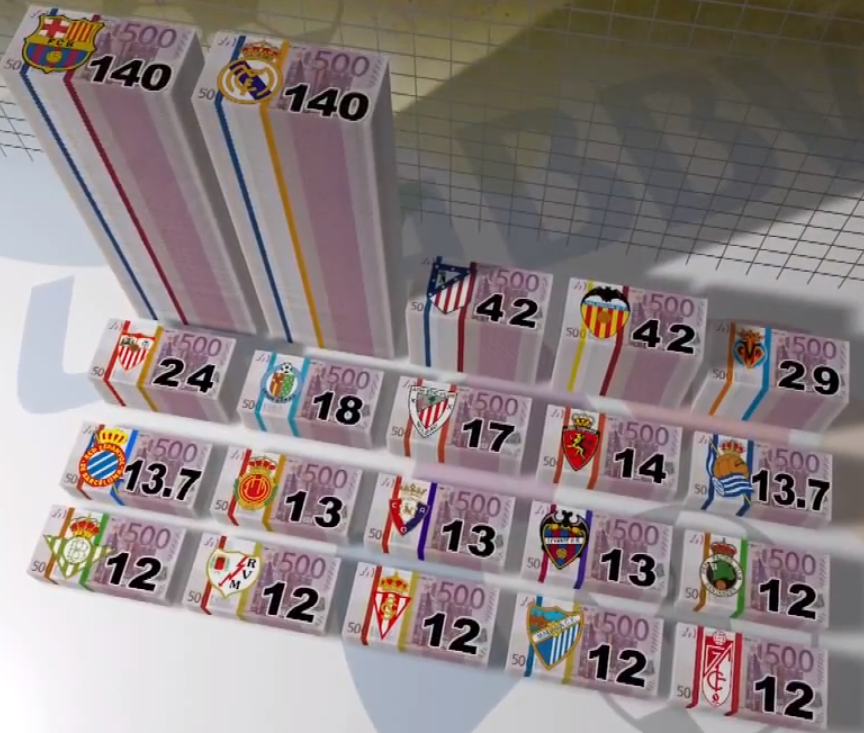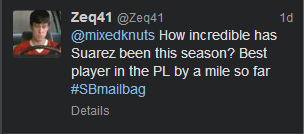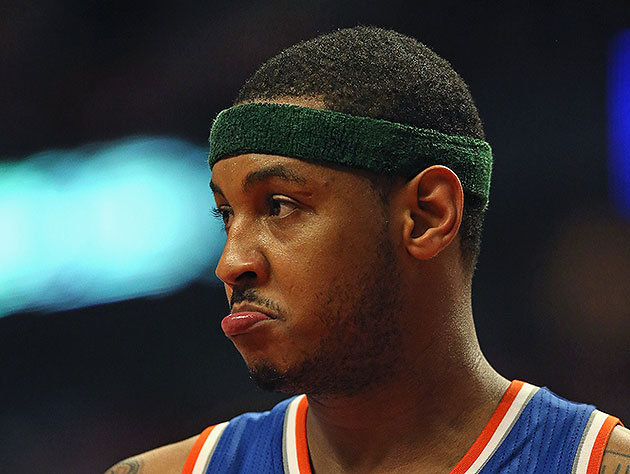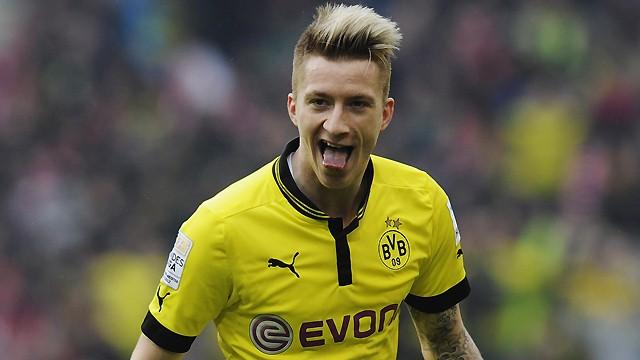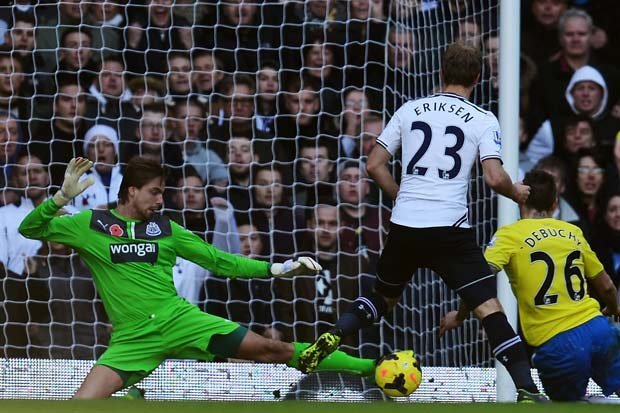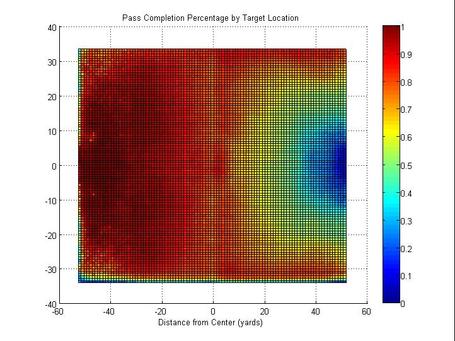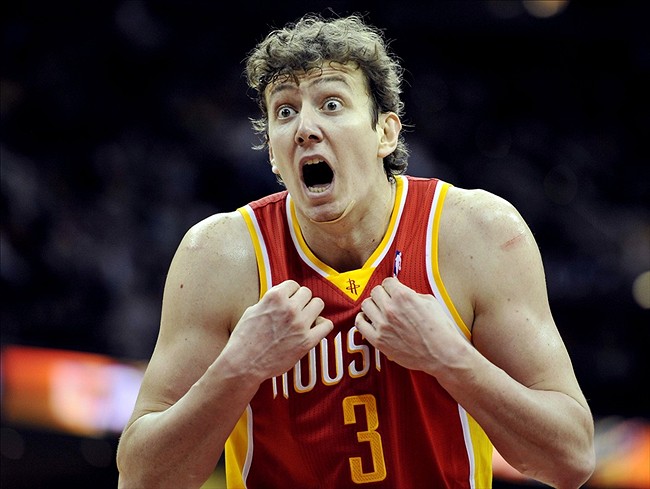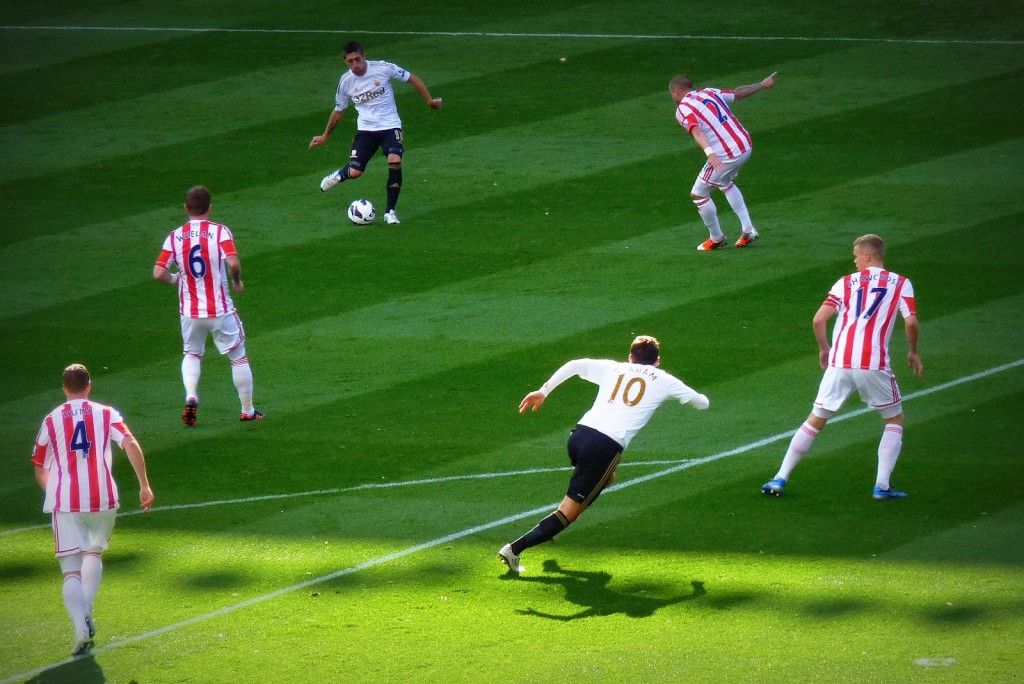Month: November 2013
Pace and Margin for Error
There isn’t just one way to win a football match.
Despite the fact that I think there are superior strategies and inferior ones (heavy crossing), football remains a complex sport filled with tactical matchups, strategies and counters, and above all, humans.
Most of whom are fallible. And one of whom is Sergio Busquets. (Check Honigstein’s mentions from yesterday for more about that one.)
Bayern Munich play significantly differently than Barcelona, who are quite a bit different than Manchester City, who are way different Atletico Madrid, who are different from Juventus, who are again different from Borussia Dortmund. Yet all of those teams are among Europe’s elite this season, and will have a fighting chance in the knock out stages of the Champions’ League, should they make it that far.
However, even with a diversity of strategy and plans available, at the end of the day the most likely way to produce winning football is to take more good shots than your opponents.
Note: A year ago, that likely would have said “more shots than your opponents,” but we’ve advanced a bit and now understand that getting into good positions before shooting dramatically affects goal likelihood. Barcelona and Fergie's Manchester United were big triggers for it, and now AVB's Spurs are a bizarro world case study. Baby steps. These days most of our analysis uses ratios of shots or shot effectiveness to examine how good teams actually are, and those are both damned interesting and useful. However, they don’t tell the complete story. 2:1 4:2 6:3 8:4 10:5 Those numbers all produce the same ratio. They do not, however, produce the same likely outputs in a football match. Confused? Bear with me.
What Is Shot Pace?
I wrote about this topic in the first football analytics piece I wrote waaay back in January *ahem*. Pace is a shorthand way of quantifying how quickly the ball travels up and down the pitch. I haven’t taken an updated look at this season’s numbers, but in general, EPL has the highest pace of all the leagues and Ligue 1 has the lowest. Scoring numbers don’t directly correlate to pace because shots on target percentages matter quite a bit, but I still like the concept and it’s simple to calculate.
So uh… why do we care about pace?
Alright, take the ratios above again, and think about that in terms of how games play out. A team with a 2:1 ratio is a highly defensive team that grinds out results, but they have to make those good shots count in order to score goals. (For what it’s worth, a ratio that low is pretty rare and I’m using it mostly as an example, but 4:2 is fairly common).
Now take the other end of the scale and the 10:5 team. It’s hard to get 10 good shots a game, and even the best teams probably only do this about half the time. Giving up 5 good shots a game is pretty high, but shooting twice as much as your opponents indicate a team is among the best in Europe, and the better team still has a fairly comfortable chance of winning despite what would be considered a loose defense by some standards. The 10:5 team plays quickly (remember, these are good shots, not all shots).
Margin for Error
So we have one dominant-but-grindy team and one dominant-and-fast team. What happens when they go a goal down early in the match? The grindy team probably has to make significant changes to their game plan in order to not only come back, but still try to win.
This can cause all sorts of problems for clubs that are used to controlling everything and suddenly have to pick up the pace in order to get a result. Shots become much less deliberately chosen, and the defense will likely struggle because it has less protection from players who are now forced to throw themselves into the attack.
The team with the fast pace… doesn’t have to change anything. So they gave up a goal… so what? They can still expect to score a bunch more throughout the course of the match if they play their normal gameplan. Obviously they don’t want to give up another goal, but they play in such a way as to mean conceding an early goal doesn’t affect the game plan at all. Mike Goodman noted in the past that Manchester United never changed their pace of play when they went down a goal – in fact, they actually seemed to slow down a bit.
If you know your normal game plan is going to score you a ton of goals anyway, why would you change? In short, despite the same general dominance in shot ratio, the team with the faster pace has a much better margin for error built in to their strategy than the team whose strategy involves grinding. Because of this, we can expect dominant teams with a faster paced strategy to perform much better over the course of a season than those who post similar ratios but play more slowly.
A Real World Example Back in August, the shot dominance for two top teams in Brazil looked like this:
Team A: 1.40
Team B: 1.46
There’s almost nothing in those numbers, and with just that information, you’d probably conclude the two teams were about equal. Now here are the actual shot counts involved in the dominance figure.
Team A: 11.6 : 8.3
Team B: 17.8 : 12.2
That is a massive difference.
The one trait I would definitely expect Team A to exhibit compared to Team B is far more draws. Despite the same ratios there, giving up a goal for Team A is far more crippling than doing so far Team B. Team A was Corinthians. Team B was Cruzeiro. Constantinos Chappas was kind enough to provide me with what the table looked like as of the date when those numbers were first pulled. At the time, Cruzeiro’s record was 5-3-2 and Corinthians was 3-5-2 (5 draws).
Fast forward to the current day and with two matches left in the season, Cruzeiro sports a 1.29 shot dominance and Corinthians has 1.19, so they stayed fairly close together in this metric throughout the season. Cruzeiro now has 23 wins, 6 draws, and 7 losses. They have also won the league and lead the second place team by 14 points, scoring 75 goals and conceding 34. Corinthians has 11 wins, 16 draws, and 9 losses.
SIXTEEN DRAWS and only two more losses than Cruzeiro. They reside in 10th place, having scored 27 goals and given up 21. With wins worth 3 points and draws worth 1, draws are suboptimal. A lot of draws coupled with a normal amount of losses will kill a team's title chances.
Conclusion and Further Research
I haven’t crunched the numbers yet across all my data, but there’s a fairly strong indication that pace will be highly correlated with draw percentages. Additionally, teams in a particular band of Shot Dominance (say 1.15 to .85) and a lower pace will also likely be monster outliers compared to league average in draw frequency.
However, draw percentages can be heavily influenced by manager strategy (Pace is as well). If managers shell when trying to protect a lead and don’t have an effective counter attack out of it, they probably draw more than a team that stays aggressive in searching for the second goal. It will be interesting to see what future research turns up here.
A fun final morsel before I go from the current Ligue 1 season.
Average league pace: 23.5 Montepellier Pace: 21.9 Montpellier Shot Dominance: 1.03 Montepellier Record: 2 wins, 9 draws, 3 losses. Goal Difference of 1. Current draw percentage of 64%.
Football Thoughts and Figures After Nov 23-24
These are my opinions and observations after the glorious return of league football.
Spurs Are a Mess
I believe in the predictive power of models. I also know that models are inherently limited in what they understand. They are a tool, but they don’t tell you everything because they can’t. Most of the time a good model will get things right, but sometimes they are missing contextual data that just makes them wrong. On the other hand, variance exists. Some teams have good and/or bad luck throughout a season. Figuring out whether something is a fluke or whether the model just doesn’t understand can be a challenge.
The predictive model that spits out the rankings here on the site thinks Spurs are Top 4 material. The table shows they are in 9th, with a goal difference of -3. Hrm.
I’m on record as liking AVB’s tactical system, but I’ve got enough data now to come to the conclusion that he doesn’t know how to coach his players to a more efficient offense. Their shooting locations are bad, especially when compared to other elite teams. They are fantastic defensively - even with some pretty mediocre personnel - but they just do not create that many great chances in the final third. Last year they were consistently Bale’d out. This year… not so much.
Don’t get me wrong, they actually do have good players in attack. Lamela and Eriksen were not mistakes – they were purchases of outstanding young players with good track records of production. Holtby could have been a mistake, but he was practically free and worth the risk. Sig has been good elsewhere, for other managers. Townsend… well, Andros is a great athlete who needs some strong coaching to realize his potential. Right now he’s too wasteful in the final third to be any good. In general, there’s talent in this Spurs squad at both ends of the pitch.
Don’t believe me? Fine, I’m just some guy. I’m not the only one who has this opinion though.
Story time…
So I’m watching the City v. Spurs pregame on Sunday and I got all excited when Sky suddenly started talking about Tottenham’s conversion stats with regard to their problems scoring goals. This is a great use of stats because Spurs have some epically bad conversion rates. Townsend has 1 goal from 45 shots. Paulinho has 1 goal from 38. Even a bog average 10% conversion rate would mean these two had at least 8 goals between them. Instead they have two.
Anyway, bully to Sky to putting useful, easy-to-understand stats in their broadcast.
They then throw it to former manager Glenn Hoddle and ask what Spurs could do to help with this problem.
Hoddle pitches this.
I’m trying to walk through his thought process for working this into the conversation at hand, and really struggling to understand what Hoddle was thinking.
“Alright, let’s see… Spurs are having trouble scoring goals. How can we fix this?”
“Aha, the first thing we’ll do is add another center back!”
“And Spurs have trouble creating good chances with service to Soldado. So what he needs is a partner up front. I’ve got it! He and Defoe would be perfect together!”
“Now we’ll keep Sandro and Paulinho in their spots because we’ve got to protect those center backs. And we’ve got wing backs to give us width and pump in those crosses to Defoe and Soldado. But we need someone in the center to pull strings and do some shooting…”
“I’ve got it! Let’s put that Townsend kid in there. He’s young, English, and shoots a lot already. I’m sure he’ll be great.”
During the same segment, he also went on to question Eriksen’s ability/production, and his formation has left out literally every single Spurs player who might be able to make a killer pass except Kyle Walker.
Glenn Hoddle, ladies and gentlemen!
In a lot of ways, I guess Hoddle and to some extent AVB show how easy it is to get things wrong on the football pitch. You have 22 guys, 4-5 potential different formations, and millions of tactical instructions. Mistakes will be made, even by smart people. However, it’s not that hard to get things right enough to be in Champions League contention with this Spurs team.
Now seeing as how Glenn had a formation he wanted to pitch, I think it’s only fair that I get to pitch my own, right? I don’t want to change much. I’d keep AVB’s shape and general tactical instructions. All I want to do is loosen up a bit in search of creativity.
It’s not that complex. Pick your best players, play them in their best positions, and do so with a mind to creating offense. Up until Sunday, Spurs had the best defensive record in the league – they can afford to loosen up a bit there in pursuit of scoring more goals because you need to score goals to win.
Attacking fullbacks are important in this formation and Spurs actually have two good ones when healthy. Rose being out is a significant loss, and it’s created the grumpy Vertonghen face time and again as the Janimal is forced to play out wide.
In the center, I’ve chosen Sandro and Dembele. Dembele gets a lot of stick, but he was good last season and consistently great for Fulham before that. Even his bad games see him active defensively and he’s an important transition player. He doesn’t shoot enough/well enough for AVB to be completely happy with him in this position, but Paulinho’s shooting has been so bad as to take away most of the benefit you’d see there anyway. You can also swap Sandro for Capoue and lose nothing. You might even gain a little bit. Capoue is that good.
The best creative passer in the squad is Eriksen by a mile, and contrary to Hoddle's opinion, he’s looked excellent in the Premier league so far. However, Lamela was also good creatively in Rome last season and he’s an excellent goalscorer too. Just play the kid in his proper fucking inverted winger position and let him go. Just because he’s left-footed doesn’t mean you should stick him on the bloody left.
This leaves you with the two real problem spots in the squad. Spurs potential forwards are 28, 29, and 31 years old. So they start at two years past their prime and work their way up to five years past by the time you get to Defoe. How did that happen?
The most talented of the lot is still Adebayor. Say what you want about attitude, when he’s focused, he’s the only forward they have that can dominate a match by himself. Find a way to bring him back into the fold and motivate the man. At this point, Spurs forward production can’t get any worse. Barring a Manu resurgence, Soldado remains the best likely second choice unless we want to get really creative and stick Lamela in the center. Personally, I’d give him a year or two and let him bulk up before doing so.
The biggest single weakness on the Spurs roster is left wing. Candidates to fill this position include three different right wings (Townsend and Lamela are inverted, Lennon is Lennon), Nacer Chadli (who clearly peed in someone’s cereal and has been relegated to Do Not Play status), and Gylfi Sigurdsson. I’d go with Sig out there and instruct he and Eriksen to interchange quite a bit, like Arsenal’s attacking mids do. Sig has an eye for a pass and can make intelligent runs. Eriksen has definitely shown he can move into space when required. The other options aren’t very good (Holtby comes into play at that point too), and this position will probably remain a weakness until the next transfer window at least.
Chelsea stealing Willian (a natural LW) away from Spurs this summer looks like a Machiavellian stroke of brilliance, as well as a wonderfully petty fuck you from Mourinho to estranged son AVB.
To me, this is the most talented lineup Spurs could field. It has some issues, but it has less than almost any other setup and has the most potential for greatness. It also relies on players who have actually proven to be good in the past (even in other leagues) versus those who merely have potential not to suck.
Whatever you think of my opinion on this matter, Spurs are clearly a mess. AVB has been consistently poor at picking Spurs personnel and playing them in the right positions, and I’m no longer sure the lack of goalscoring is a freakish occurrence. More data is required.
Liverpool Notes
Another weekend, another Suarez goal. I wrote about this last week – he could actually average over 1 goal per90 this season, heights achieved only Ronaldo and Messi.
Get excited Liverpool fans, but if whatever you do, don’t tell Suarez. You want Luis to be a cliche. Play within himself. Do whatever it takes to help the team. Once Luis starts dream chasing, he could revert back to selfish Suarez, which will hurt LFC's CL chances. Just keep it on the downlow and quietly appreciate what has started out as an amazing season.
You need Suarez quietly speaking affirmations to himself like, “Tengo hambre. Tengo que comer carne humana. Tal vez voy a morder Ronaldo o Messi.”
Which is Suarez for, “I just want to help my brothers at Liverpool to win. I must work hard to be great like Ronaldo and Messi.”
Speaking of Liverpool, their shots on target conceded percentage last season was 31.6%. This season it looks like 38.5%. That’s way too much work for Mignolet for Rodgers to be happy, even if the shots they are giving up aren’t necessarily from good positions. The defense is better than last year through 12 games (16 conceded versus 13), but it’s still a work in progress. Personnel at center back now seems quite good though.
They still have a chance to be top of the league in mid-December.
David Moyes, Still at Everton?
“Moyes was less sanguine. “Disappointed,” he said. “It was similar to Southampton when we had the game under control with a minute to go and then we conceded from a set piece. We can’t keep dropping two points and we could have played better, but it’s a tough place to come after international duty and I would have taken the result before the game.”
Which place is tough, Dave? Wales? Newly promoted Cardiff? Draws on the road against promoted sides are something you’d willingly accept as Manchester United manager?
Maybe Moyes was just putting a healthy spin on a match that didn’t go their way, but that’s not a statement or sentiment I would want floating around in the press if I were the manager of Manchester United.
Maybe there’s a reason why Fergie said some completely barmy things whenever United struggled in a match they should have won. He certainly wouldn’t have been happy with a point on the road against Cardiff.
Lambert and the Poor Villans
More strange manager comments, this time from Paul Lambert in the Birmingham Mail. In that article, Lambert laments not having enough money to pay Lukaku’s wages on loan last year (while fellow Midlands club West Brom did).
However, instead of paying for Lukaku, Aston Villa bought Christian Benteke. And then instead of doing the same thing this season, they bought guys like Leandro Bacuna and Nicklas Helenius, etc. They now own them. Arguably, Benteke and Lukaku would have been worth almost identical amounts had they been sold this summer.
I don’t know about you, but instead of having Lukaku on loan for a season or two, I would much rather own Benteke and Bacuna. This is exactly what Premier League clubs should be doing. Scout for bargains, bring them in, train them up in the Premier League, and eventually sell them to bigger clubs for a massive profit (which they will eventually get on both of these guys). Rinse and repeat.
Renting younger or middle-aged players for a season is correct in the Championship (provided the wages aren’t too much), especially because it’s harder to get talent to transfer to Champ clubs permanently. It’s a poor use of money for most Premier League clubs though, especially ones who are trying to improve their team for the long term.
Don’t be sorry you couldn’t afford Lukaku, Paul. Just keep finding and polishing gems and everything will turn out right.
Southampton’s Concession Stand
Southampton have given up a total of seven goals this season, the best in the Premier League and three fewer than the next closest team. Of these seven, they include
- A header from 5’5” Emanuele Giaccherini
- A kick from Stoke goalie Asmir Begovic, made from his own 18.
- Olivier Giroud stealing the ball from Artur Boruc for the easiest goal he will score this season.
- And a penalty against Arsenal, given after a shirt tug on Mertesacker in the box was noticed by a referee. These fouls are constant and are never called.
Arsenal were 1 goal favs on Saturday. If they give up just one of the improbable goals, the bet pushes. Obviously they gave up two. Let’s watch the Boruc Cruyff turn one more time.
Both the Stoke and Sunderland goals turned bets on Southampton into losers.
Conclusion: The betting gods hate Southampton fans.
Drawing Dead?
Nurnberg currently share the bottom of the Bundesliga table, having won exactly zero matches in thirteen games. They do, however, have eight points this season, meaning they have drawn an astounding 61% of their matches so far. The next closest number of draws in the league are Freiburg and Frankfurt with five, both of whom are also hovering near the relegation zone.
I noticed this over the weekend, and it prompted me to poke around the other leagues in Europe searching for other crazy draw teams. Everton lead the Premier League with six draws so far this season, or 50% of their matches. The highest in the usually draw prevalent Serie A is 6 out of 13 from Torino.
There is, however, with an even higher draw rate than Nurnberg. That team resides in France, where Montpellier have shared the honors an amazing 9 out of 14 matches so far (64%). France is traditionally the league with the highest percentage in Europe, but Montpellier are special even for there. They are 16th in the table… with a goal difference of -1!
Dear young managers across the world: draws are not your friend.
Leo Messi? Meh.
I was talking to someone at work this weekend about Champions League matches, and we noticed that Ribery, Ronaldo, and Messi are all likely out from the matches this week. While pondering how much Madrid would miss Ronaldo, he noted that Barcelona had struggled since Messi started getting injured.
This is the common wisdom. Messi is the best player in the world. He has the highest scoring rate ever seen in the modern game. Clearly Barcelona would miss him.
But what does the data say?
In four matches sans-Messi this season (I’m including his injury game where he only lasted 20 minutes), Barcelona won 0-1 at Malaga, 4-1 at home to Valladolid, 1-4 at Betis (inj game), and 4-0 against Granada. The competition there is pretty weak, but that’s La Liga for you.
At the end of last season, Messi missed six matches. In those games they produced a 5-0 versus Mallorca, 0-3 at Zaragoza, 1-0 versus Levante, 2-1 versus Valladolid, 0-2 at Espanyol, and 4-1 to Malaga. Six matches against unimpressive competition, but also six more wins.
That makes Barcelona 10-0-0 in their last ten league matches without superman, winning by an average of 2.6 goals per match.
Yes they were demolished by Bayern Munich in the Champions League, and having Messi around there certainly would have helped, but overall they haven’t struggled even a little without the little man in La Liga.
Are Barcelona a better team with Messi around? Obviously. Is his presence vital to their ability to win La Liga this year? Probably not. Alexis and Neymar are thriving this season under Tata, and moving Cesc into the center of the pitch has given the team more attacking versatility than we’ve seen from Barcelona in years.
Messi’s great, but Barcelona don’t need him to trounce the average Spanish team. As for Real and Ronaldo… Benzema, Bale, Morata, and Di Maria seem pretty dangerous without him around as well.
We’ll know more on Wednesday night.
A Final Note
A lot of people have been asking me to write transfer pieces for the January window. Obviously it's great to have people excited about my work in that area. Expect to see some research and shopping pieces December 16th or so. I'm waiting to have as much data as possible from the current season before flagging players for specific teams and positions.
Saturday Ramble: Notes & Previews
Welcome to the Saturday morning Ramble.
Notes
Fellaini Can Play Better (LINK) If we replace the word can with must then we are getting there. In fact, I have a problem with the word can. Can Fellaini play better in his current tactical position in the Man United system? Hart Must Wait (LINK) Quotes from Pellegrini to the tune of "Hart is good, but he must wait for his chance" Personally, I think Hart should slide back in for the Tottenham game, but what do I know. Interesting words at the end of this piece on Vincent Kompany and muscle injuries. A question: If any person knows which leg Kompany had that severe achilles injury on then please let me know? Giggs is 40 Next Friday Henry Winter has the words. Giggs will be 40. FORTY! All things considered is he the greatest PL player? Madrid Away At Almeria How many will Madrid score, how many will "Commandante Ronaldo" score?  Ronaldo is a laughable 4/11 anytime goalscorer. (nice photoshop)
Ronaldo is a laughable 4/11 anytime goalscorer. (nice photoshop)
Must Read
Jon Bois is brilliant. If you are not aware of who he is then please find some time and google his name and read everything he has written on SBNation. Breaking Madden is a must read (and watch) every single time it's published. this weeks edition on the great Bo Jackson may have been the most enjoyable and fun thing I have seen since he published the previous weeksBreaking Madden. "A metaphor for an insane amount of things in life" - @mixedknuts 
Previews
Everton v Liverpool Derbies: notoriously difficult to pick. The odds on the Asian Handicap are Everton (0) 2.1 Liverpool (0) 1.85. Everton are a pretty decent side but I think Liverpool are the stronger outfit and in Suarez they possess a genuine game changing player. Liverpool have spent an awful lot of time in winning positions this year (it's gonna regress, trust me) whilst Everton draw a lot.
| Ave Time | Win | Draw | Lose |
| Everton | 19.9 | 61.6 | 8.5 |
| Liverpool | 47.3 | 29.5 | 13.2 |
How does this sound: First goal scored by Everton and score draw at full-time? Fulham v Swansea Fulham are bad by the basic shots count despite their points haul. Sorry, scrap that, Fulham are fucking terrible by the shots count. Fulham (grey) and the Bottom 6: 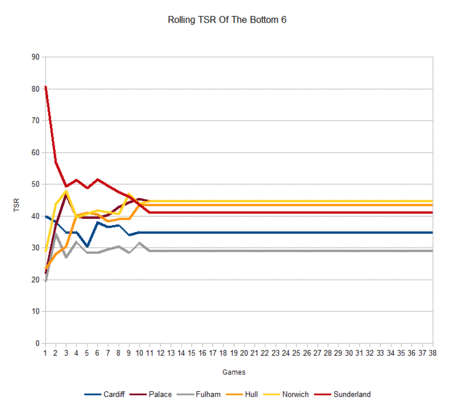 Even if we place Fulham against the PL's worst teams they still look bad. Fulham's ability to exert control on games is non-existent and it shows in things like this poor TSR number. Fulham host a Swansea side who are a good shots team, a near-excellent shots on target team and have a SoT rating that is among the best in the league. Now, Fulham's shots number will probably improve given time but I'm not sure that improvement will happen today against a nice Swansea side who, it must be said, can sometimes wilt away from home. Fulham (+0.25) 1.925 Swansea (-0.25) 2.00 Unless something crazy happens then I quite like Swansea's chances of getting a win. A draw if you don't feel brave. Hull v Crystal Palace Palace have a new manager in Tony Pulis! Pulis won't save Palace and he probably won't bring them back up either. But that's life. Hull and Palace have very similar shots, SoT and shots efficiency profiles. Hull have points, Palace don't. Hull's PDO is 102. Palace's PDO is 78.3. Regression is a thing but I'm not sure it'll happen today. Pretty hard to imagine Palace getting anything from this game Stoke v Sunderland I don't really care for this game. Stoke are trying to break old, bad habits. Sunderland are doing the same. Both teams will desperately struggle to break those old habits in today's fixture which will likely render it unwatchable. West Ham v Chelsea West Ham are quietly struggling with some underlying numbers: about average by TSR, pretty poor by SoTR and the shots on target rating doesn't look too hot:
Even if we place Fulham against the PL's worst teams they still look bad. Fulham's ability to exert control on games is non-existent and it shows in things like this poor TSR number. Fulham host a Swansea side who are a good shots team, a near-excellent shots on target team and have a SoT rating that is among the best in the league. Now, Fulham's shots number will probably improve given time but I'm not sure that improvement will happen today against a nice Swansea side who, it must be said, can sometimes wilt away from home. Fulham (+0.25) 1.925 Swansea (-0.25) 2.00 Unless something crazy happens then I quite like Swansea's chances of getting a win. A draw if you don't feel brave. Hull v Crystal Palace Palace have a new manager in Tony Pulis! Pulis won't save Palace and he probably won't bring them back up either. But that's life. Hull and Palace have very similar shots, SoT and shots efficiency profiles. Hull have points, Palace don't. Hull's PDO is 102. Palace's PDO is 78.3. Regression is a thing but I'm not sure it'll happen today. Pretty hard to imagine Palace getting anything from this game Stoke v Sunderland I don't really care for this game. Stoke are trying to break old, bad habits. Sunderland are doing the same. Both teams will desperately struggle to break those old habits in today's fixture which will likely render it unwatchable. West Ham v Chelsea West Ham are quietly struggling with some underlying numbers: about average by TSR, pretty poor by SoTR and the shots on target rating doesn't look too hot:
| SoT% Rating | SoT % For | SoT% Prevention | |
| West Ham | 92.49 | 24.64 | 67.86 |
West Ham are struggling to get shots on target and aren't even league average in prevention. Today they face a Chelsea team who are good at all the things that West ham are not. Chelsea are +.75 on the handicap. I'm not totally convinced of that line but hey, what do I know! Arsenal v Southampton (The PDO Derby) Probably the biggest fixture of the day. Both teams have had mighty good starts to the campaign but there are warning signs for both teams. For Arsenal it's the scoring% and PDO at Tied and plus 1 GS: 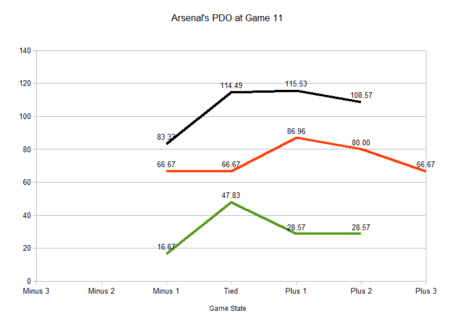 I'm not sure Arsenal can continue to score at that rate at Tied or maintain that Save% at +1. For Southampton, the slightly concerning element of their play is the super high Save%:
I'm not sure Arsenal can continue to score at that rate at Tied or maintain that Save% at +1. For Southampton, the slightly concerning element of their play is the super high Save%: 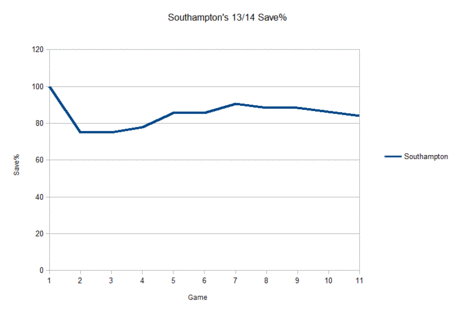 League average save% is ~71% this term so that Southampton number looks pretty darn good/unsustainable. So, both teams have some slightly unsustainable numbers but don't let that take away from the fact that both teams have some excellent underlying fundamentals. Both Arsenal and Southampton are very good at controlling games which shows in both teams residing the top 5 in terms of shots ratio and shots on target ratio. It's also worth noting that these teams hold the highest PDO's in the league with 112 each. 100 is the league average and we know PDO tends to regress toward the mean over time. It should be a fascinating systems battle. Arsenal may shade it, but I'm not totally convinced. The draw is 3/1.
League average save% is ~71% this term so that Southampton number looks pretty darn good/unsustainable. So, both teams have some slightly unsustainable numbers but don't let that take away from the fact that both teams have some excellent underlying fundamentals. Both Arsenal and Southampton are very good at controlling games which shows in both teams residing the top 5 in terms of shots ratio and shots on target ratio. It's also worth noting that these teams hold the highest PDO's in the league with 112 each. 100 is the league average and we know PDO tends to regress toward the mean over time. It should be a fascinating systems battle. Arsenal may shade it, but I'm not totally convinced. The draw is 3/1.
Building a Better Football Club
Since I also do a lot of thinking about this type of thing, I wanted to write a companion piece to Richard Whittall’s 21st Club article on Directors of Football. I liked what Rich said a lot, but I wanted to put on my consultant's hat and discuss something beyond Rich’s focus on that specific role that I don’t think I’ve seen expressed.
Most football clubs are incredibly inefficient.
Take the job of the traditional English manager. On the surface, he needs to be an expert in player evaluation (picking the first 11), coaching players to improve, plus systemic tactics and adaptation. In short, he needs to be able to pick the players and choose the tactics that will get the most out of them on the pitch.
I haven’t done the manager’s job, but I have read a lot about it, and apparently just the roles listed above take a lot of time.
Now layer on the following additional roles that the traditional English manager would at least need to be able to have a conversation about:
Physiology and diet.
Financial budgeting.
Scouting.
Youth Development (which actually differs significantly from first team management).
Statistical analysis.
Anything else that teams somehow end up consulting the manager on.
That’s a lot of stuff. Like, multiple degrees at university amounts of stuff. Even a certified genius is going to have trouble adding value in every one of those areas, especially when the bulk of football managers spend 30 years of their lives focusing primarily on learning to play football.
We know from years of business research that having one person be an expert in everything is extremely inefficient. They usually act as a bottleneck inside of an organization, which makes everyone else do their job worse, and cause confusion and frustration up and down the line. Needing that same person to at least be familiar with all that stuff is also inefficient and in many cases just plain impossible.
Now take a step back for a second and ask another question with regard to football:
Where do teams spend the most money?
Transfers and player wages. By a massive amount.
If I’m consulting at a business that has this problem, this is where I focus to get the most gains. Let's make this area better first, then we can work on everything else.
So the real question then becomes: how do you make transfers and player wages more efficient?
Step 1) Add a director of football type role.
This is what Rich was talking about in his piece. Someone who brings together all the different aspects of running a football club and makes certain they comply with a coherent, long-term plan. This is especially true because changing plans is expensive. Managers in the current climate survive less than a year and a half. How the hell can you run a business with that type of turnover when you have to change plans every time you hire a new manager?
A Director of Football is a high level management role. On the other hand, football inherently has a lower wage structure outside of players and the best managers because people are desperate to work there. I would guess the cost is £80-200K per year, but a much wider variation would not surprise me.
Changing plans from one manager to another every 15 months is far more expensive than that.
Step 2) Hire an analytics department to help with both on-the-field stuff, but especially, to help with scouting and transfers.
If you spend the most money on transfers and player wages, you need to make them as efficient as possible. How do you eek the most performance per dollar from this area? Well, you could potentially spend more money on scouting. Orrrr… you could hire a team to crunch numbers from football leagues all over the world in an effort to find the best players possible for as little money as possible.
Even if you are sceptical about how big an impact stats can have in finding good players – and you shouldn’t be, because some of us have started proving this with public data in our spare time – the biggest single thing statistical scouting will help teams do is make fewer mistakes. And that’s massive.
I could build a strong analytics department with a manager, a programmer, and 3 solid stats guys for £150-200K a year plus data costs.
One bad transfer costs millions. One good transfer that you get on the cheap and then sell on a year or two later raises millions.
Step 3) Hire better managers.
This one is interesting, because manager hiring seems to be a total crapshoot. Reputations are built on mythology and shared belief more than results. Results themselves only tell one part of the picture for what is going with a team, and are at least in part driven by the players a manager had at their disposal.
So how do you cut through all the crap and find better managers?
Data.
This is why I started working on Statistical Fingerprints. We now know a ton about how players play, but how much do you really know about how managers coach their teams? Crunch the numbers and figure it out.
Because a manager has such a huge impact – even if you limit their responsibilities to just stuff that happens on the pitch – it is vital to have as much information as possible before hiring a new one. Great managers that everyone knows are hugely expensive to hire. Great managers dealing with lesser talent, but whose football teams are producing good numbers… those guys are a lot easier. Provided you have the data to do it.
At this point, teams that aren’t looking to stats to figure out how a manager operates are buying expensive lottery tickets and hoping it turns into their retirement plan.
You do not want to know how much money is spent paying off fired managers every single season. It's shocking.
Step 4) Develop Players Better.
I don’t have any advice on this one because it’s not my area of expertise. All I can say is that if the majority of money in your organization is spent on players, then you need to support them with the best coaching staff you can find.
Additionally, if you are trying to spend LESS money on players, developing them internally from the youth ranks up is the way to do it. It doesn’t cost you transfer money to buy them, no agent fees are involved, and you get players who have cheaper wages and presumably who fit with the organization’s plan. You might even be able to create a profitable player pipeline like Southampton did while they were slumming in the lower leagues.
Conclusion
Regardless of how much money they bring in, teams must become more efficient in how they operate, and in particular they have to become more efficient in getting the most out of their transfer budget and wage spending. Smaller teams that are trying to become more competitive almost can’t afford not to do this.
- Diversify the responsibility within a football club to actual subject matter experts.
- Spend more money on the staff that finds new players (by adding a statistical scouting and analysis department), and also money on the staff that develops new players. If spending on players is the greatest cost in your organization, you MUST make sure the money is used as efficiently as possible.
- Start using numbers across your organization to provide data points that put everyone on the same page.
Your football club will become more efficient. Your player scouting and development will as well. And the results will eventually show up on the field.
The only way it makes sense to just ignore this stuff is if you don’t view a football club as a business and instead view it as a rich person’s plaything.
Although incredibly, two of the biggest “rich person’s plaything” clubs in England (Chelsea and Manchester City) are also leaders in diversification of responsibility and using an analytical approach to all areas of their… business?
Key Pass Locations and Man United's Woes
Due to the work that the likes of Paul Riley and I have undertaken in recent times we now have a greater understanding of the importance of shot location. Of course, it’s totally obvious that shooting from close in spots will be more rewarding than taking shots from Andros Townsend territory, but it’s not that long ago that shot location wasn’t as topical as it is now. OK, so now that some progress has been made on where shots are taken from, how about we go one step back in the attacking chain and spend some time looking at where the passes were made from for the shots that were taken? Like shot location, I would assume that the location of the final pass before the shot (“Key Pass” in Opta language) will have some bearing on the chances of the subsequent shot being scored. It would therefore be helpful to be able to monitor and manage the areas that teams allow key passes to be played from as it provides them with another KPI to target and manage. Obviously a team will try their best to limit shots from good locations, but if they were able to also manage the areas that they allow the Key Passes to be played from that just might leave it easier for them to ensure that the shots from good locations don’t actually occur. Once again, to the best of my knowledge, the only person that has done any work in this regard has been Paul Riley. Passing Zones Let’s try to firstly establish a few parameters, and we will use the following pitch layout to categorise the zones where the final pass before the shots originated from: 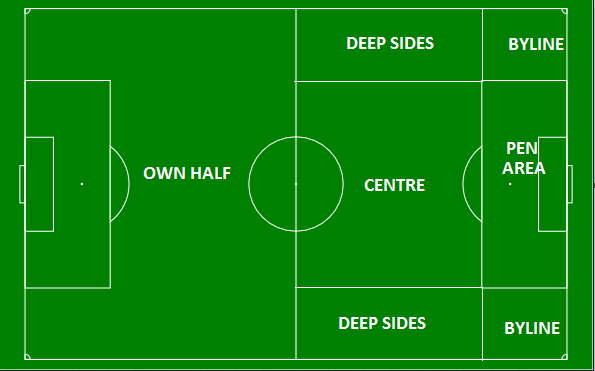 To aid analysis I have broken the pitch into 5 zones, and used data from StatsZone and Squawka to log the location of each chance created in the Big 5 Leagues for the current season. Remember, in this study we are interested in where the pass that set up the shot originated from, not where the shot was taken from. Here is the summary table showing the probability of a Key Pass resulting in a goal for the games played to date in the 2013/14 big 5 leagues:
To aid analysis I have broken the pitch into 5 zones, and used data from StatsZone and Squawka to log the location of each chance created in the Big 5 Leagues for the current season. Remember, in this study we are interested in where the pass that set up the shot originated from, not where the shot was taken from. Here is the summary table showing the probability of a Key Pass resulting in a goal for the games played to date in the 2013/14 big 5 leagues: 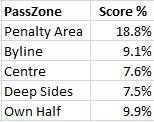 Encouragingly, those numbers look like they make sense.. 18.8% of shots (regardless of where they are taken from) that come as a result of a pass played from within the Penalty area result in a goal. As expected, this zone provides the highest strike rate amongst our passing zones. The next most lucrative passing zone in terms of the scoring of subsequent shots is passes played from a team’s own half. At first glance this seems counter intuitive, but I think it does make some sense. Remember, we’re not saying that a high proportion of all passes played from a team’s own half results in a goal. Rather, where a pass leads to a shot and that pass originated from a player’s own half then we get a decent conversion rate of almost 10%. I would venture that this success rate is due to the fact that such a pass may result in a through ball or some other form of counter attack where the opposition defence is not adequately set and thus the conversion rate is better than for the other zones. Next we have shots from passes made from the Byline zones which see a conversion of 9.1%, and finally we see that shots which stem from passes made from deeper than the edge of the Penalty area have the lowest conversion rate. It doesn’t seem to matter whether these passes are made from the centre of the pitch or towards the sidelines as both zones see a similarly low conversion rate of 7.5%. Presumably the overall conversion rates are reduced within these passing zones as a large majority of the passes that lead to a shot will be played in front of the defence, and thus the shot will be relatively easy to defend against. There is no doubt that any macro analysis such as this will miss out some individual subtleties in that not every shot that comes from a pass played from within the penalty area will be gilt edged. Likewise, not every shot that comes from a pass further out the field will have a low probability of being scored as it may split the defence and leave the striker in a one on one situation against the opposition goalkeeper. However, it’s incredibly useful to be able to see the general impact on probable shot conversion that is implicit in the location of the Key Pass. And besides, we have to start somewhere with new analysis!!! Significance of those findings Now that we have ascertained the conversion parameters around each of the passing zones, what next? Teams know that having shots in good locations is helpful in attempting to score goals and win games. Of course, no team sets out to shoot from bad spots, or indeed wilfully allow the opposition to shoot from good locations, but it is equally important for a team to know the impact of where the final pass comes from in determining the probability of any shot resulting in a goal. Crucially, this information may be able to help explain why certain teams are struggling to score goals or keep them out at the other end. It may be able to tell us why certain teams seem to give up high quality chances as opposed to us having to settle for the fact that we just report on the fact that they do. A case in point is Man United in this current EPL season. Attacking 2013/14 Attacking Passing Zones: Proportion of Key Passes from each zone [table id=44 /] Note that not all shots follow on from a pass. So any shots that come about as a result of a misplaced defensive pass or a tackle will not be included in the table, as no pass has been played. Earlier we seen how valuable shot assists which originated in the penalty area were in terms of contributing towards a team’s goal count and so the above table has been sorted in descending order of Penalty area zone percentages. As teams will create different numbers of shots, in order to aid analysis I have used the percentage of the origin of passes of a team’s total as opposed to the absolute numbers. Liverpool has created the highest percentage of their chances from the penalty area (25%) and they are closely followed by Southampton. Man City, and perhaps surprisingly Tottenham and Cardiff complete the teams that manage to create more than 1 in every 5 shots they take from the confines of the penalty area. As we look further down the table we see that, of the big named teams, Man United and Chelsea have struggled to create chances from close in with just 15% and 14% of their respective chances being created from here. Giving Chelsea the benefit of the doubt, perhaps if a team is full of attacking playmakers and attacking midfielders they are happy to thread high quality passes through from zones which generally wouldn’t expect to see a great deal of success. The Byline zone lives up to expectation with both Stoke and West Ham being the only teams to have 30% or more of their chances coming from the byline. I would suggest that Man City is at a sweet spot with ranking 3rd in the table for the percentage of their shots that originate from both the penalty area and the byline. We have ascertained earlier that the average goal probability for shots stemming from passes played from the Centre and Deep Sides zones are converted at similar rates. So although the difference in conversion rates is minimal I am showing the figures for the two zones separately as it helps identify a team’s style of play. We’re not surprised to see that Arsenal rank highly with 53% of all shots coming from Central zone passes, nor that Stoke sit bottom of this section at 30%. Fulham sitting above the Gunners at 54% is a little more surprising however. Man United
Encouragingly, those numbers look like they make sense.. 18.8% of shots (regardless of where they are taken from) that come as a result of a pass played from within the Penalty area result in a goal. As expected, this zone provides the highest strike rate amongst our passing zones. The next most lucrative passing zone in terms of the scoring of subsequent shots is passes played from a team’s own half. At first glance this seems counter intuitive, but I think it does make some sense. Remember, we’re not saying that a high proportion of all passes played from a team’s own half results in a goal. Rather, where a pass leads to a shot and that pass originated from a player’s own half then we get a decent conversion rate of almost 10%. I would venture that this success rate is due to the fact that such a pass may result in a through ball or some other form of counter attack where the opposition defence is not adequately set and thus the conversion rate is better than for the other zones. Next we have shots from passes made from the Byline zones which see a conversion of 9.1%, and finally we see that shots which stem from passes made from deeper than the edge of the Penalty area have the lowest conversion rate. It doesn’t seem to matter whether these passes are made from the centre of the pitch or towards the sidelines as both zones see a similarly low conversion rate of 7.5%. Presumably the overall conversion rates are reduced within these passing zones as a large majority of the passes that lead to a shot will be played in front of the defence, and thus the shot will be relatively easy to defend against. There is no doubt that any macro analysis such as this will miss out some individual subtleties in that not every shot that comes from a pass played from within the penalty area will be gilt edged. Likewise, not every shot that comes from a pass further out the field will have a low probability of being scored as it may split the defence and leave the striker in a one on one situation against the opposition goalkeeper. However, it’s incredibly useful to be able to see the general impact on probable shot conversion that is implicit in the location of the Key Pass. And besides, we have to start somewhere with new analysis!!! Significance of those findings Now that we have ascertained the conversion parameters around each of the passing zones, what next? Teams know that having shots in good locations is helpful in attempting to score goals and win games. Of course, no team sets out to shoot from bad spots, or indeed wilfully allow the opposition to shoot from good locations, but it is equally important for a team to know the impact of where the final pass comes from in determining the probability of any shot resulting in a goal. Crucially, this information may be able to help explain why certain teams are struggling to score goals or keep them out at the other end. It may be able to tell us why certain teams seem to give up high quality chances as opposed to us having to settle for the fact that we just report on the fact that they do. A case in point is Man United in this current EPL season. Attacking 2013/14 Attacking Passing Zones: Proportion of Key Passes from each zone [table id=44 /] Note that not all shots follow on from a pass. So any shots that come about as a result of a misplaced defensive pass or a tackle will not be included in the table, as no pass has been played. Earlier we seen how valuable shot assists which originated in the penalty area were in terms of contributing towards a team’s goal count and so the above table has been sorted in descending order of Penalty area zone percentages. As teams will create different numbers of shots, in order to aid analysis I have used the percentage of the origin of passes of a team’s total as opposed to the absolute numbers. Liverpool has created the highest percentage of their chances from the penalty area (25%) and they are closely followed by Southampton. Man City, and perhaps surprisingly Tottenham and Cardiff complete the teams that manage to create more than 1 in every 5 shots they take from the confines of the penalty area. As we look further down the table we see that, of the big named teams, Man United and Chelsea have struggled to create chances from close in with just 15% and 14% of their respective chances being created from here. Giving Chelsea the benefit of the doubt, perhaps if a team is full of attacking playmakers and attacking midfielders they are happy to thread high quality passes through from zones which generally wouldn’t expect to see a great deal of success. The Byline zone lives up to expectation with both Stoke and West Ham being the only teams to have 30% or more of their chances coming from the byline. I would suggest that Man City is at a sweet spot with ranking 3rd in the table for the percentage of their shots that originate from both the penalty area and the byline. We have ascertained earlier that the average goal probability for shots stemming from passes played from the Centre and Deep Sides zones are converted at similar rates. So although the difference in conversion rates is minimal I am showing the figures for the two zones separately as it helps identify a team’s style of play. We’re not surprised to see that Arsenal rank highly with 53% of all shots coming from Central zone passes, nor that Stoke sit bottom of this section at 30%. Fulham sitting above the Gunners at 54% is a little more surprising however. Man United 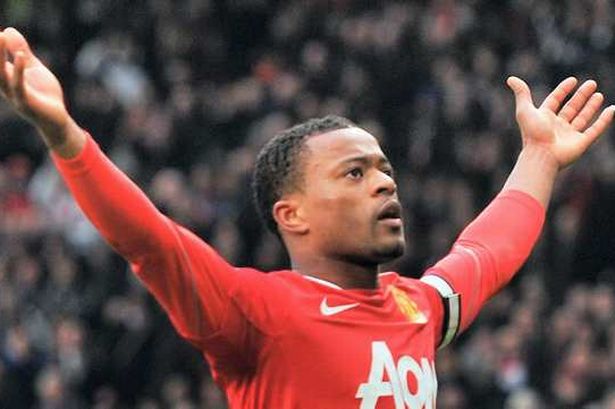 The Deep Sides numbers are very interesting, or at least Man United’s figure in this zone interests me. We can see that Man United, at 22%, is the only team to create more than 19% of their chances from these Deep Sides zones, which is not a great claim to fame as this zone has a low probability of Key Passes resulting in goals. Can we suggest that passes from this zone show the least imagination and they are the easiest position to get to, with the resulting lowest probability in producing a goal once they create a shot? Can this help us understand why Man United is struggling this season? 2012/13 Attacking Numbers Before we jump to any conclusions, let’s see what the above numbers looked like for last season (2012/13): [table id=45 /] Man City topped the table with 27% of their shots coming from passes from within the penalty area, but Man United was hot on their tails with 24% from this same zone. This figure is more in line with the expectation of the League Champions, and a club of the quality of Man United. Now let’s look at the Deep Sides category for last season. Man United had just 12% of their chances created coming from this zone last year – only West Brom had less than United. So it appears that Man United is attacking differently this season, and not in ways that are good. They have swapped chances being created from within the penalty area with ones being created from the deep sides; which doesn't sound like a great deal to me.......... Why would they do that? Is the answer David Moyes? Could he have “broken” Man United in just 11 games? Not only have United increased their percentage of shots that come from Deep Sides passes from 12% to 22% this season, but coincidentally look what has happened Everton’s numbers during the same time period. Under Moyes last season, Everton had 20% of their Key Passes delivered from the Deep Sides zone, but so far this season, under Martinez, Everton have played just 12% of their shot assists from this zone. It certainly appears that this particular set of numbers is systemic, and I don’t imagine that they will please the majority of Man United fans. Surely they expected more of Moyes than to turn Man United into Everton? Key Pass Contributors Last season Rooney and Van Persie created a combined 3.97 Key Passes per90 minutes. Their combined creative output this season sits at just 2.33 per90, with Van Persie seeing the largest reduction in his Key Pass numbers. Everton fans won’t be surprised to see that it’s Patrice Evra, United’s left back, that has been the main beneficiary of Van Persie’s reduced number of chances created. Last season under Fergie, Evra had just 0.66 Key Passes per90, and this season with Moyes at the helm he has more than doubled his output by creating 1.49 per90. Meanwhile over at Goodison Park, Leighton Baines was the Premier League’s top Key Pass creator last season with 116, this equates to 2.85 per90 minutes. At this point it is worth noting that I include injury time in my minutes played calculations. During the opening 11 games of the new season, Baines has only averaged 1.18 Key Passes per90, which is substantially lower than last season. I know that we are only talking about two players across one and a bit seasons but there certainly appears to be some weird David Moyes / Left Back penchant going on, perhaps to the detriment to the team and other important creative players. Defense
The Deep Sides numbers are very interesting, or at least Man United’s figure in this zone interests me. We can see that Man United, at 22%, is the only team to create more than 19% of their chances from these Deep Sides zones, which is not a great claim to fame as this zone has a low probability of Key Passes resulting in goals. Can we suggest that passes from this zone show the least imagination and they are the easiest position to get to, with the resulting lowest probability in producing a goal once they create a shot? Can this help us understand why Man United is struggling this season? 2012/13 Attacking Numbers Before we jump to any conclusions, let’s see what the above numbers looked like for last season (2012/13): [table id=45 /] Man City topped the table with 27% of their shots coming from passes from within the penalty area, but Man United was hot on their tails with 24% from this same zone. This figure is more in line with the expectation of the League Champions, and a club of the quality of Man United. Now let’s look at the Deep Sides category for last season. Man United had just 12% of their chances created coming from this zone last year – only West Brom had less than United. So it appears that Man United is attacking differently this season, and not in ways that are good. They have swapped chances being created from within the penalty area with ones being created from the deep sides; which doesn't sound like a great deal to me.......... Why would they do that? Is the answer David Moyes? Could he have “broken” Man United in just 11 games? Not only have United increased their percentage of shots that come from Deep Sides passes from 12% to 22% this season, but coincidentally look what has happened Everton’s numbers during the same time period. Under Moyes last season, Everton had 20% of their Key Passes delivered from the Deep Sides zone, but so far this season, under Martinez, Everton have played just 12% of their shot assists from this zone. It certainly appears that this particular set of numbers is systemic, and I don’t imagine that they will please the majority of Man United fans. Surely they expected more of Moyes than to turn Man United into Everton? Key Pass Contributors Last season Rooney and Van Persie created a combined 3.97 Key Passes per90 minutes. Their combined creative output this season sits at just 2.33 per90, with Van Persie seeing the largest reduction in his Key Pass numbers. Everton fans won’t be surprised to see that it’s Patrice Evra, United’s left back, that has been the main beneficiary of Van Persie’s reduced number of chances created. Last season under Fergie, Evra had just 0.66 Key Passes per90, and this season with Moyes at the helm he has more than doubled his output by creating 1.49 per90. Meanwhile over at Goodison Park, Leighton Baines was the Premier League’s top Key Pass creator last season with 116, this equates to 2.85 per90 minutes. At this point it is worth noting that I include injury time in my minutes played calculations. During the opening 11 games of the new season, Baines has only averaged 1.18 Key Passes per90, which is substantially lower than last season. I know that we are only talking about two players across one and a bit seasons but there certainly appears to be some weird David Moyes / Left Back penchant going on, perhaps to the detriment to the team and other important creative players. Defense 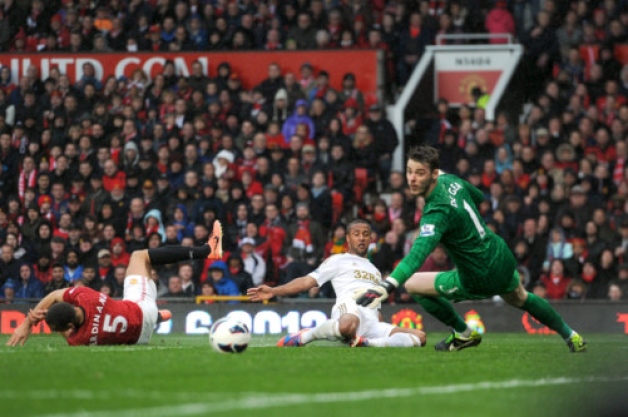 Worryingly for United, it’s not just going forward that they have struggled this season. Up until two weeks ago, the quality of the average chance conceded by Man United was the highest by any team in the 2013/13 Premier League. Norwich’s 7-0 drubbing at Man City has seen that mantle now passed to the Canaries, but after 11 games the quality of the shot allowed by Man United is the second highest in the league. As defending champions, that statistic is incredibly disappointing and perhaps the metric under analysis in this article can shed some light on just why the chances United are giving up this season are so good. Here is the table for where passes originated for shots conceded by each team in the current EPL season: [table id=46 /] We can see that one quarter of all shots that United give up are set up by a pass from within the penalty area. Unsurprisingly, that number is the worst in the league. But look at the teams that follow them in this table; Crystal Palace, Norwich, Aston Villa, Newcastle and Fulham. None of those teams will expect to be competing for European places this season, and unless Moyes can prevent the opposition from creating chances from within United’s penalty area neither will Man United. In a somewhat cruel twist of fate, Everton have performed exceptionally well in this measure with an amazingly low 7% of shots created by passes from within the penalty area; this represents just 6 shots in 11 games. There is a danger in over fitting the statistics to fit the narrative, but there seems to be something at work that is affecting the potency of United’s defence, as well as their attack. Last season United topped the league in blocking 30% of the opposition’s shots. Like the other measures we have looked at in this piece, they have considerably underperformed that threshold this season. Their block rate is just 21% during the opening 11 games – this ranks them second from bottom in this measures. Has some hesitancy crept into their defending? Does the reduction in the number of shots being blocked support that view? The large increase in the proportion of shots that are set up by the opposition from within the penalty area suggests that teams are finding it easier to attack through the heart of United this season. I have no doubt that the proportion of shots that Everton conceded which follow passes from inside the penalty area will regress as that 7% figure is off the scale (the lowest for any team last season was 15%). But at this stage it looks like Roberto Martinez may well have been a better fit for Man United than David Moyes appears to be.
Worryingly for United, it’s not just going forward that they have struggled this season. Up until two weeks ago, the quality of the average chance conceded by Man United was the highest by any team in the 2013/13 Premier League. Norwich’s 7-0 drubbing at Man City has seen that mantle now passed to the Canaries, but after 11 games the quality of the shot allowed by Man United is the second highest in the league. As defending champions, that statistic is incredibly disappointing and perhaps the metric under analysis in this article can shed some light on just why the chances United are giving up this season are so good. Here is the table for where passes originated for shots conceded by each team in the current EPL season: [table id=46 /] We can see that one quarter of all shots that United give up are set up by a pass from within the penalty area. Unsurprisingly, that number is the worst in the league. But look at the teams that follow them in this table; Crystal Palace, Norwich, Aston Villa, Newcastle and Fulham. None of those teams will expect to be competing for European places this season, and unless Moyes can prevent the opposition from creating chances from within United’s penalty area neither will Man United. In a somewhat cruel twist of fate, Everton have performed exceptionally well in this measure with an amazingly low 7% of shots created by passes from within the penalty area; this represents just 6 shots in 11 games. There is a danger in over fitting the statistics to fit the narrative, but there seems to be something at work that is affecting the potency of United’s defence, as well as their attack. Last season United topped the league in blocking 30% of the opposition’s shots. Like the other measures we have looked at in this piece, they have considerably underperformed that threshold this season. Their block rate is just 21% during the opening 11 games – this ranks them second from bottom in this measures. Has some hesitancy crept into their defending? Does the reduction in the number of shots being blocked support that view? The large increase in the proportion of shots that are set up by the opposition from within the penalty area suggests that teams are finding it easier to attack through the heart of United this season. I have no doubt that the proportion of shots that Everton conceded which follow passes from inside the penalty area will regress as that 7% figure is off the scale (the lowest for any team last season was 15%). But at this stage it looks like Roberto Martinez may well have been a better fit for Man United than David Moyes appears to be.
Mailbag - Can Suarez Make EPL History, Stats Resources, and Much More
I really like mailbag columns from my favourite writers. Take a smart, opinionated writer, add clever questions from smart readers, shake and enjoy. I don’t know where we’ll find the smart writer for this one, but you guys had plenty of good questions this week, so let’s dive right in.
*For those thrown off by the word "dive," we'll talk about Luis Suarez later in the column.
There are a couple of parts to this question that I feel deserve some attention, so bear with me.
First, defense is not sexy. If you are writing about football stats in public and working on defense, no one is going to read your stuff. It can be pretty disheartening. Thus very little work has been done by the analytics community in this area, and what has been done usually has a tight team or player focus (excepting Paul Riley’s or Colin’s GK work, both of which look at GK vs. expected goals based on shot location).
However, defense is damned important. Possibly more important than offensive work overall, especially when it comes to teams that are mid-table or below and have to worry about relegation.
My own complaints stem more from the fact that I can’t quantify defense with public information. Goalkeeper stats basically don’t exist in a crunchable form, and we know they are directly connected to how a team’s defense plays. Defender stats are mostly rate stats (Ints, clearances, blocks, tackles per game). Error stats – which are enormously important because of how big a probability they have in producing opposing goals – also do not exist in a crunchable format, so we know next to nothing about them. They also don’t have much history behind them, so analysis would end up drawing conclusions from annoyingly small sample sizes.
Does this information exist? In a word, yes.
Opta, who are certainly the gold standard in football data and rapidly approaching a monopoly in this area, track all of this information. Unfortunately for people like myself, Ben, and Colin Trainor, as well as many other amateur statistical analysts, there isn’t any sort of research or student option to subscribe to Opta’s data at all. None of us are professors, but what we do is similar to work you would see done by academics in this area.
There was one pay source for error stats (and a lot more) for the Premier League last season at EPL Index, but that disappeared as a public source with the new season. I was willing to pay 40-50£ a year for EPL Index, and I’d certainly be willing to do that per league for the rest of the leagues Opta tracks. On the other hand, I can’t pay £5000 per league per year or whatever it is they charge at the corporate and team level, so I just work with public sources. (And now we’re back to where we started.)
If Opta were to make some sort of researcher subscription model available, they’d have a new revenue source, and would dramatically speed up the research for what we know about football. That said, I’m not sure whether that fits into their business model at all. Then again, given that their position as a data provider and their desire for more and more uses for their stats to come out, maybe it’s something they should think about?
(Note: StatsBomb is not monetized, and none of us work for companies using the data.)
Here's another important thing to realize: I spend twice as much time collecting data as I do analysing or writing it and so do most of the guys who do football analytics. It’s a minimum of about 8 hours a week, every week, just spent typing numbers into a spreadsheet. Imagine if you could wipe out 90% of that data time and put it toward research. One year from when I started looking at this stuff, we still mostly exist in the dark ages. Oh well.
Back to topic at hand, we could certainly do a lot more on the defensive side with even basic data. The big breakthrough, however, would be defensive positional information. I wrote a bit about this in the summer, but it’s become especially apparent with the release of information about NBA’s SportVu player tracking that this is a) inevitable and b) a HUGE next step in football.
All of the expected goal models out there do a lot of hand waving about defensive positioning. “These shots occurred from these spots and are typically this probability of scoring a goal.” There’s nothing wrong with it and it’s done by necessity, but having positioning information for every single player on the pitch would change everything.
The following questions were produced in about sixty seconds of thought on what this information would let us answer.
- Who shoots the best under defensive pressure?
- How close do defenders need to be to shooters to have the best chance of disrupting or blocking a shot?
- Is it better to shoot from 22 yards with 3 yards of space or 20 yards with 1.5 yards of space?
- Which GK are just inherently positioned wrong on long shots?
- Where SHOULD GK be positioned on long shots to have the best chance of saving shots from locations X, Y, and Z?
The questions are endless, and despite the fact that many of them look like research for pure knowledge, the vast majority have practical applications. Do the research, find the results, create the teaching points for your coaches. This is true at the league level and at the national federation level. It feels like this is something that would immediately get funded by the Germany Ministry of Sport and the US Soccer Federation, but would get argued about for years and never funded in England.
Hell, forget Opta (who barely broke even during their last fiscal year), and think about the three biggest monetary entities in the sport. Isn’t this the sort of greater good project – one that benefits the teams, the players, and the fans – that should see some of the billions in revenue that FIFA, UEFA, and the Premier League generate every year thrown at it? Learning more about the sport as a whole can only be a positive, right?
So yeah. Make more info public, and we can do a lot better with basic defensive info. Make a lot more info available to the right people and you’ll completely change what we know about the game of football.
At first, I got whatever stats I could from whatever source I could. These days there are four primary locations I get information from, all powered by Opta.
The first one on my list is WhoScored. I like their layout, how quickly the site responds, and the fact that they have information going back to the start of the 2009-10 season for most of the bigger leagues. It would significantly improve my life if they would opt to post information in a Per90 format instead of how they do it, and there’s more basic information I would like to see (tackle success rates and defensive errors plus minutes played are probably tops on the list), but overall I really like the site.
For team stats, if they made some really simple, useful additions like goals against per game, goals for per game, and shots on target conceded per game, I’d probably kiss Cris Acconci directly on the mouth when I eventually meet him.
Also, if anybody ever crosses the information at WS plus the breakdowns for performance by player over at Transfrmarket, plus shot location info like Colin does, it would turn into the site I use 90% of the time instead of 60%.
The second site I use regularly for stats is Squawka. Squawka has some incredibly powerful information and breakdowns, displays some simply lovely graphical representations, and wraps everything in an interface I hate. I assume they do this so that script kiddies can’t scrape the everloving shit out of their website, which I completely understand, but it interferes with my enjoyment of the site. It is, however, the only place you can get some extremely important information like passing breakdowns and percentages for players by type.
Without the information there, it probably would have taken much longer for the world to prove it is a helluva lot harder to pass the ball with your head than with your feet.
Example: Olivier Giroud has a passing accuracy of 78% with his feet this season (182/232)and 32.5% with his head (29/89).
And here’s a second example, just because the mental image made me laugh.
Example 2: Xavi had 2405 successful passes with his feet last season out of 2507 total "general" passes (95.9%). He also had 11 successful and 5 missed headed passes (69%).
Conclusion: Using your head is hard, even for Xavi. (And Xavi likely never gets beat up on aerial challenges the way forwards do.)
The third place I get stats is from the FourFourTwo StatsZone, which is kind of the gold standard for graphical stats displays in football. It’s really easy to plonk images created there into article pieces, and they have some great information. They’ve also recently added at least one league I can’t find anywhere else, which guarantees them traffic from me.
The final place I get data from is The Football App on my ipad. I’m apparently not the only one, since The Guardian actually did a profile on them last month, and they’ve had explosive growth. Transcribing all of their information from ipad to PC is about as much fun as going to the dentist, but the app itself is really quite good.
(Note: Apparently it’s available to people who run Windows 8.1 or higher. This would require me choosing to use Windows 8. Having used Windows 8, I fully intend to skip this generation of MS upgrades and hope the next version is less awful.)
Despite being asked by a reader named UnfitForPurpose, this is a great question because it lends itself to a couple of different analytical approaches.
If you are looking purely at money, then Bayern Munichare far and away the best team in Germany, and have the single biggest monetary advantage of any team in Europe versus the rest of the teams in their country. They have been one of the best teams in Europe consistently over the last five years (at least) while making a profit.
In fact, they have made a profit twenty years in a row.
Mind. Blown.
Incredibly, they have sandbagged their spending overall to make certain that the Bundesliga remains consistently competitive. The problem they have is that they also want to win the Champions League, and other teams across Europe don’t share their cares about competitive league balance. Is Bayern choosing to splash out more of their revenue to win more CL medals going to cause issues in the coming seasons for the rest of the Bundesliga? It certainly could. The Pep Guardiolas of the world don’t come cheap.
For the moment, Dortmund are every bit as good as Bayern and now have enough spending power to stay fairly close in player quality in the first XI. The problem is that Bayern are literally two-deep with exceptional talent at every position. Dortmund go about 15 deep and then fill in with a bunch of potentially talented kids. There’s a large separation between those two and the rest of the league, but at least Bayern have competitive company for now.
If you want simple league metrics, Spain remains the most ridiculous. Atletico are really exceptional this season, but Barcelona and Real Madrid always win the league, and the TV distro looks like this:
Teams on the bottom get no money. Goal differences for the top 2 teams are regularly absurd. With Barce and Madrid getting nearly 12x the TV revenue alone compared to the smallest clubs, and 3X the third and fourth closest, competitive balance will be a problem in Spain forever and ever and ever and ever…
In terms of what the predictive model thinks, SerieA now has the biggest separation between how good the team at the top is versus all the other teams. Since Totti and Gervinho went down injured, Juventus have started playing much better, and Roma have fallen off a bit. This has lead to a .75 goal expectation for Juve versus the second place team (Roma) on a neutral pitch, which is currently the largest of any league I track in Europe. I don’t think the gulf is nearly that large if Roma is fully healthy, but Juve are both good and deep. It will be interesting to see if the other top teams in Italy can keep up with them, or whether The Old Lady from Turin will gradually pull away from what is actually a pretty good league this season.
It’s only six matches, but the man with the Cameron avatar is exactly correct – Suarez has been out of his mind this season.
A goal a game in the Premier League is awesome. Suarez is currently bettering that by a third. Multiply that by a full 38 game season and you end up with 50 goals. You know who has posted rate stats to get 50 league goals in a season?
Ronaldo.
Messi.
That’s it, at least in modern times. That’s bonkers.
It's not just the goal rate that's great though - Suarez is incredibly involved in the Liverpool offense. 41 passes per game looks closer to a midfielder than a forward, and his key pass and dribble stats are strong. The Loss of Possession stats are still a bit too high for comfort (Offsides, Dispossession, Turnovers), but look what you get for it! Suarez has been amazing.
I wrote something this summer on how Suarez was incredibly inefficient, to the point of driving fans and analysts (and presumably Brendan Rodgers) crazy. His conversion rate over the last two seasons was the lowest of any major forward in Europe. That plus the discipline issues completely drove me off him as a player, and I believed that Liverpool should absolutely snap off a bid of £40M from interested teams. Except maybe from Arsenal, who they would be directly competing with to make the Champions League next year.
HOWEVER… there was this nagging issue of his performance for Uruguay clogging up the analysis. When playing for his national team, Suarez wasn’t good plus inefficient – he was actually just great. If Liverpool could ever figure out how to translate Uruguayan Luis into Liverpudlian Luis, watch out. I didn’t think it could happen.
So far this season, Suarez is converting shots to goals at a 22% clip and getting 42% of his shots on target. That’s light years better than his recent Premier League conversion (38.5% SOT last year and 12.3% non-penalty conversion rate).
It’s just six matches so far this year, but maybe Rodgers and co. did it? If so, I am happy to own up on being wrong. If nothing else, they should now be able to hold out for a bid more like what PSG paid for Cavani’s services next summer, should they even want to sell/Suarez still wants to leave.
Can it continue?
This one is a bit like Arsenal winning the Premier League for me. Historic precedent and underlying stats suggest that their hot run won’t continue for the rest of the season, but it’s in the realm of possibility now. And if Suarez averages a goal a game for Liverpool for the rest of the season, and if they manage to keep the rest of their attack healthy…
Liverpool are definitely going to make the Champions League. They might even battle it out for the league title.
Those are still pretty big ifs, but they no longer reside in the realm of wishful thinking.
What’s up with Crystal Palace’s manager situation?
Okay, I made this one up because I wanted to talk about it. It’s a strange spot for a number of reasons, not least because it seems to be taking quite a while to hire a manager in the most desirable league in the world. The issues become a lot more obvious when you work through the problem.
Right now Crystal Palace are probably 95% likely to be relegated. They don’t have a ton of talent, they sold one of their two best attackers from last season to Manchester United, and their other one (Glen Murray) is still recovering from a blown ACL. That’s not a great place to start a battle for Premier League survival.
Unlike Sunderland, who hired Gus Poyet earlier this month while also navigating the bottom of the Premier League, Palace’s fundamentals just aren’t as good. They don’t have as much money, and their roster isn’t nearly as talented as the Wearside club. Palace do have a good youth program in place though, and they are clearly thinking in the right direction regarding future player recruitment by hiring Moody as Sporting Director.
Now say you are one of the better managers in the English Championship right now. Your goal is to get to the Premier League.
Why wouldn’t you take the Palace job?
Because there’s a second unstated half of that goal – “To make it to the Premier League… and stay there.” If I’m an up and coming manager, I don’t want to just make it to the PL, I also want a fighting chance to stay there, and Palace’s current situation doesn’t provide that. If I believe in myself and my team in the lower league, it’s actually more likely that I will be in the Premier League next year if I get my current team promoted instead.
Similar issues arise with foreign managers. They look at the squad composition and how unlikely it is they will survive this season and say, “Meh, I have it better here. Something better will come up.”
I don’t actually know what Palace are likely to do, but I think they have two real options. They should either find a caretaker to see out this season, (and pay them a massive bonus if they were to somehow accomplish a miracle and survive), and then do their entire search again in the summer when their league status is known.
Or they should hire a younger manager from the lower leagues (League One and below) who can develop talent to finish this season and set up their run for the Championship next season (where they will suddenly be a club flush with cash). All their other options just have too many incentives vs. interest issues to end up hiring a manager you actually want running the club for the long term.
---
That’s it for me today. Thank you for all of the questions you guys submitted, and maybe we’ll do this again toward Christmas, when half of the leagues will be on their winter breaks.
--@mixedknuts
Don't Tank!: The Four Phases of NBA Franchises
Supposedly, the Phoenix Suns, Philadelphia 76ers, and Orlando Magic are all “tanking”: purposefully losing games in order to get a better pick in the 2014 draft, which has been forecasted as completely incredible for years. If that’s the case, they all suck at tanking, since the Suns and Magic have scored more points than their opponents, and the 76ers are 5-6. The Suns are even above .500. The nerve of those players, playing to the best of their ability. When the 76ers started the year 3-0, there was a combination of shock, amusement, bewilderment, and panic. ESPN even published a post about how they needed to blow up the roster, in order to tank better. You know… blow it up again, after trading away their All-Star point guard for a rookie who won’t play this season. This is, in fact, not what the 76ers should do, and articles like that betray a lack of understanding as to how to build a good team for the future. Regardless of how many games the Suns are winning, they are rebuilding the right way. They traded off players that were old, expensive, or otherwise not useful to a rebuilding franchise. In exchange, they get up to four picks in the 2014 first round, and three more in the second. They also have some great young talent on the roster, and even better, their highest-paid player is Goran Dragic at $7.5m (whom I’ve already discussed them trading). Losing games is overrated. Sure, it gives teams better odds of getting that #1 pick, but that’s all it gives: odds, not a guarantee, and it doesn’t shift the odds that dramatically. The worst team in the league only gets a 25% chance at the #1 pick. Playing reasonably well, on the other hand, makes their players more valuable: Markieff Morris, as of this writing, is #10 in the league in PER, and #8 in win shares per 48. During the offseason, you were more likely to hear jokes about Phoenix’s twins than genuine interest, but now people are genuinely impressed with him. Young players, playing well, get you trade offers. And trade offers lead to more draft picks, and more good young players. Sure you and I might know how sample size works, but do New York Knicks executives? As I see it, there are four rough stages to building a team:
- Acquire long-term assets
- Get a superstar
- Build around your star
- Contend for the title
The tanking that people talk about is usually just acquiring long-term assets, in the form of draft picks and project players. These teams can afford to think five years down the line, and exploit that by nabbing assets from teams that are in a later stage of building their team (commonly referred to as “win now.” The 76ers are a great example here: their oldest players are three 25 year-olds. They have talented players in Evan Turner, Spencer Hawes, and the current Rookie of the Year frontrunner Michael Carter-Williams. They traded a second-round pick (top 50 protected!) for Tony Wroten, the 25th pick in the 2012 draft, from a team that couldn’t give him any minutes. He’s played more minutes in 11 games with the 76ers than he did in his rookie season with the Grizzlies. He made sports news with a triple-double in his first start (an arbitrary and meaningless measurement, but still kinda cool), and SportsCenter with some impressive plays. [youtube id="7CV0xTc4EV0" width="633" height="356"] Ask yourself: if the 76ers asked teams about a trade involving Tony Wroten, what do you think they’d get in return? Probably more than a relevance-protected second-round pick. These teams aren’t going to keep up their initial hot starts, of course. The 76ers have already come back to earth, and with a DRTG (points allowed per 100 possessions) of 108.6, they’re the worst-defending team in basketball. Their margin of victory puts them at 27th overall. But they’ve made people notice them. Defenders of tanking often point to the "Thunder model," of how the Oklahoma City Thunder swiftly built a championship contender seemingly out of nothing. The way I look at history is that they got absurdly lucky. If we go back to the 2007 draft, when they picked up Kevin Durant, they only had the fifth-worst record, which gave them an 18.5% chance of getting one of the first two picks. But getting the first pick would have probably led them to picking the consensus #1 pick, Greg Oden, so the only situation where their franchise ends up so well is exactly at the #2 slot. The following year, they got slightly unlucky to not get one of the first three picks in the draft, but both Michael Beasley and O.J. Mayo have massively underperformed expectations after going second and third in that draft. Russell Westbrook wasn't really thought of as someone with massive superstar potential, at the time. Serge Ibaka wasn't even a lottery pick, and they got him in the same draft, and turned him into one of the better forwards in the league. In the next draft, they seemingly reached for James Harden with the third pick (after once again dodging the #2 pick bust Hasheem Thabeet) when mock drafts had Ricky Rubio as an "easy" pick. Obviously, lottery chance affects every franchise, leading to an infinite number of "what-ifs." But it's pretty obvious that a team's expected value from three lottery picks in consecutive years is a lot lower than that of Kevin Durant, Russell Westbrook, and James Harden. That's an incredible run of draft picks, and most teams would be overjoyed to have one of those players emerge from a non-first-overall pick. Imitating a team that got where they are by that much luck will not lead to very good results. An alternate plan: if you give minutes to a bunch of recent draft picks, project castoffs from other teams, and D-League callups, most of those players will not be good. Some of them will even be atrocious. Back when the 76ers thought they were a decent team, they had a rookie named Nikola Vucevic that they drafted 16th, and got buried in their lineup. He played pretty well for a rookie in his 800-ish minutes. He ended up as a throw-in from the 76ers to the Magic in the four-team Dwight Howard/Andre Iguodala/Andrew Bynum trade, and the Magic actually gave the guy some minutes. He had a startlingly good sophomore season with them, and is exceeding it this year, becoming more efficient on more shots. This will not happen every time, or most of the time, or half the time. But if you’re an asset-acquiring team, you can afford to play a bunch of young guys and find out who’s secretly a pretty good NBA starter. “Pretty good” might sound unexciting, especially in a league where so much depends on the best ten players, but if a guy is winning games for you while making less than $2m a year, as Vucevic is, that’s an incredible deal. All the guys who didn’t work out, the team is free to decline their rookie options, and they’ll probably get 10-day contracts or play overseas after that. If your team can find a couple starters at bargain-bin prices while sifting through junk, that’ll pay off when you move to the next phases of team-building. Teams leave the asset-acquiring stage when they acquire a legitimate superstar. The traditional way (and the expected one from people that talk of tanking) is to acquire one with an early lottery pick. Just like the worst team has better odds, but a low overall chance, of the best pick in a draft, the #1 pick has the best odds, but no guarantee, of being the best player in their draft class. Looking from 2003 (when LeBron was the first pick) through the 2012 draft, the first pick has been superstar-quality six times (LeBron, Dwight Howard, Derrick Rose, Blake Griffin, Kyrie Irving, Anthony Davis), a very good player twice (John Wall and Andrew Bogut), somewhat of a bust in the case of Andrea Bargnani, and derailed by injury in the case of Greg Oden. 60% chance at a superstar is fantastic, there’s no doubt about that. But looking at things from the opposite direction, the picture is muddied a bit. Of the top 20 players by PER who came into the league in 2003 or later, only three of them were the #1 overall pick. 17 of them were from the lottery, though, with only David West and JJ Hickson being drafted in the non-lottery first round, and Paul Millsap from the second round. The first pick is unquestionably better, there’s no doubt about that, but getting a collection of lottery picks can, taken collectively, give a team just as good odds at a superstar. Drafting a star is so prone to random chance that many teams decide to use their assets to trade for one instead. This has worked out really well for Houston with James Harden, and not quite as well for the some more famous teams, but we’ll get to that. The opportunities to trade for or sign legitimate stars don’t happen often, and when they do, they inevitably result in year-long media assaults that make me want to follow curling or competitive Magic: the Gathering instead. By the nature of the bidding war that teams go through to acquire that player, the acquiring team almost inevitably ends up overpaying, leaving the team with a skeletonized roster ill-equipped to compete alongside that player. In the long run, this is fine and necessary for the franchise to move forward, but it can lead to a lot of doomsday predictions when the “new and improved” team underperforms. The team will probably be saddled with the overpaid castoffs that the star’s former team demanded the acquiring team take with, and the best of the young assets the team got in the previous phase have to get shipped out. At any given time, there are probably fewer than 15 players that I’d consider to be legitimate superstar-quality. It might even be as low as five. This isn’t to disparage the second tier, or to start a meaningless fight over who is or isn’t “elite” a la ESPN screaming head shows, but to caution a team against blowing everything to acquire that most dreaded player: the False Superstar. Some of them are great players, but, as the sports media catchphrase goes, aren’t good enough to be the best player on a championship team. The more sinister ones put up empty numbers. If a team trades their assets and takes on the enormous contract of the false superstar, they might be completely screwed for half a decade. Their assets are all sunk into one big, untradeable contract, and due to sunk costs, they’re resigned to building around their false superstar, leading to early playoff losses or worse. Fans more accustomed to other sports might raise an eyebrow at the importance given to acquiring one single superstar, rather than a solid overall team. What difference does it make if you have one player contributing 20 wins above replacement, or two players contributing ten each? There are a few reasons for this: the easiest is to look at a game of basketball. More than any other sport, an individual player can have a huge impact on every single play. It’s not an exaggeration to say that both team’s gameplans, on both sides of the ball, center around LeBron James every second he’s on the court. Even football quarterbacks can, at most, be the focus of 50% of a team’s attention, unless Peyton Manning takes up free safety at some point. Second, superstar players have an even bigger impact when it comes playoff time. During the regular season, these players might average 36 minutes per game. In the playoffs, it will very often be over 40. LeBron has a career playoff average of 43.1 minutes per game. This is enough of a change to completely exclude the lower parts of a team’s rotation, and the killer second units that propel certain teams through the regular season become less relevant. Lastly and perhaps most importantly: contracts. NBA contracts are capped at a certain amount, according to an unbelievably complex formula that I can neither explain nor comprehend. The gist, though, is that there’s a certain dollar amount that’s a “max contract,” and that’s the most that player can get paid for that time period. Salary cap genius Larry Coon wrote an analysis (behind ESPN’s paywall, unfortunately) of the league’s most underpaid and overpaid players. The two most underpaid players, in terms of absolute difference between salary and value created, are… LeBron James and Kevin Durant. Those are the two best players in the NBA. If a player creates $16m in value per year, and your team pays him $15m per year for this, your team is basically getting screwed. The value in a superstar comes from their surplus value, because all that unspent salary can be spread among the rest of a team’s players. If your highest-paid player is only creating wins at the rate you’re paying them for, that’s a one-way ticket to the middle of the league. Good luck leaving there when you’re paying someone $15m per year. The only way around this is if a team somehow gets stuffed full of Kawhi Leonard and Kenneth Faried clones; ie, players who aren’t stars, but have a star-like gap between their expected and actual salaries. This is impossible, though, because these players are rare (they have to be low draft picks who produce way more than expected), absurdly valuable as trade assets, and their incredible surplus value lasts only as long as their four-year rookie contract. So how does a team avoid a false superstar? A real superstar is either a true two-way monster, like Paul George, Dwight Howard, or LeBron; or they’re so outrageously productive offensively that their defense can be mitigated, like James Harden, Steph Curry, or Kevin Love. A false superstar produces offense, but gives up just as many points on defense. They might also chuck up tons of shots, and expect people to be impressed with their nightly double-double. Do not trade for these players. They will hurt you. As the Knicks have learned since they acquired Carmelo Anthony, getting a star is not the end. The next step is finding where he fits, and getting players that fit around him. For a while, this was looking pretty good: they were playing Carmelo at power forward, where he is excellent offensively and less-bad defensively, next to defensive powerhouse Tyson Chandler and an array of three-point shooters to stretch the floor while Carmelo went to work. Then, they took this extremely solid gameplan and handed it to James Dolan, who used it to wipe his sweaty testicles. It was disgusting, and now they have a roster composed entirely of players who play the same position as Carmelo. 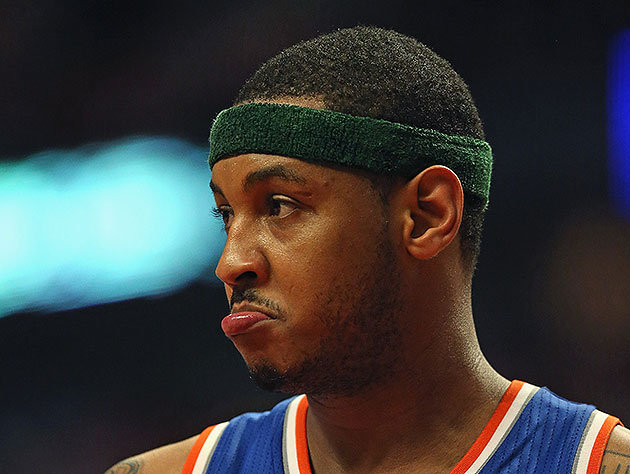 Chandler and shooters are a great fit for a team built around Carmelo, because the former players are all low-usage guys, and Carmelo creates value by taking a ton of more-efficient-than-average shots. In theory, this should lead to those low-usage players all being efficient with the shots they end up taking, and playing great defense to compensate for Carmelo’s laziness on that end. This plan is not limited to New York. The general team makeup of a star scorer, a defensive big, and a roster of shooters is on full display in Indiana, San Antonio, Houston, Golden State, and a few other teams are moving toward it. This has led to the increase in emphasis on three-and-D guys, and they’re getting harder to find. It’s not much of a stretch to see a future where the best of this archetype are getting max contracts from teams with money to spend, if they already have the superstar to build around. Andre Iguodala, the rocket-powered version of that player, might not have been the build-around player the 76ers were looking for, but he’s having a grand old time with the Warriors: leading the league with an absurd true shooting of .715, at the lowest usage% since his rookie year. All that’s left after those stages is title contention. Sign the veterans that other teams bought out, trade your near-useless draft picks for bench depth, and cross your fingers that Michael Carter-Williams doesn’t beat you in the Finals.
Chandler and shooters are a great fit for a team built around Carmelo, because the former players are all low-usage guys, and Carmelo creates value by taking a ton of more-efficient-than-average shots. In theory, this should lead to those low-usage players all being efficient with the shots they end up taking, and playing great defense to compensate for Carmelo’s laziness on that end. This plan is not limited to New York. The general team makeup of a star scorer, a defensive big, and a roster of shooters is on full display in Indiana, San Antonio, Houston, Golden State, and a few other teams are moving toward it. This has led to the increase in emphasis on three-and-D guys, and they’re getting harder to find. It’s not much of a stretch to see a future where the best of this archetype are getting max contracts from teams with money to spend, if they already have the superstar to build around. Andre Iguodala, the rocket-powered version of that player, might not have been the build-around player the 76ers were looking for, but he’s having a grand old time with the Warriors: leading the league with an absurd true shooting of .715, at the lowest usage% since his rookie year. All that’s left after those stages is title contention. Sign the veterans that other teams bought out, trade your near-useless draft picks for bench depth, and cross your fingers that Michael Carter-Williams doesn’t beat you in the Finals.
StatsBomb Predictive Models – Bundesliga, Serie A, Eredivisie Week 12
[I wrote this intro for my initial predictive model piece, but most people probably haven’t read that one, so it bears repeating here.] I work for a very large internet bookie. Because of this, I’m heavily restricted in what I’m allowed to write about. So despite the fact that I’m a subject matter expert in English Premier League betting, I ain’t writin’ about it, no way, no how. You’ll see me occasionally discuss my betting opinions on Champions’ League matches or American Football on Twitter, but that’s about it. (I don’t actually work on the Champions’ League product and used to bet College Football professionally before working at Pinnacle, so there's wiggle room.) Anyway, I do other stuff at work too, including dabbling in predictive models. I can’t produce weekly picks for you, but one of the things I can do is discuss some point-in-time power rankings. Most of the models I’ve looked at become active after week 5, including the latest iteration of my own. For fun, I’ll post the initial rankings here for most of the European leagues as they come online, and you guys can argue about them until your heart is content or filled with hatred. Either way. Why Should You Care? You probably shouldn’t. This model is just stuff I play with during my spare time, and I’m certain it doesn’t have the brainpower or man hours put into it as something like the European Club Index from Infostrada. On the other hand, the most recent version of this model has been in play since June, and has done a good job picking out the good and bad teams in Brazil and MLS very quickly. Simpler versions of this model also predicted Augsburg would pick themselves up off the bottom of the Bundesliga and escape relegation last season, which they did. Sadly, it also thought Deportivo would save themselves from doom in Spain, but missed that one due to three losses in their last four matches. Ya win some long shots… A quick note on methodology: These rankings know nothing about the league table. They don’t care what team is in first and what team is in last, and operate on an entirely separate statistical methodology. They have a large n of data across multiple seasons of testing behind them and are predictive of future league places in the table, but variance exists. Eredivisie Week 13(ish) [4 teams have 12 because of pitch issues] 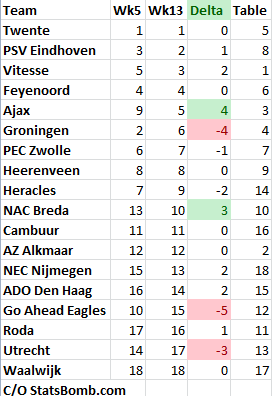 League Winner: Twente, PSV CL Spot: Twente, PSV, Vitesse Relegation: Waalwijk. Utrecht and Roda both in danger. Welcome to the craziest league in Europe. A league where the teams who were at the top have basically eschewed winning any matches for the last three weeks or so. A league where 3-3 is somehow a normal scoreline. How weird is this league right now? The team with the best goal differential is in 5th. The team with the third best goal dif is in 8th. The only other major league where the GD leader isn’t in the top two right now is England, and it's bloody strange there too. Also, more than half the teams in the league have a positive goal differential. It’s a lot of fun to follow the stories and read the writing of people like Michiel Jongsma, Nikos Overheul, and Peter McVitie who are covering the league. Movers and Shakers Ajax has made a fairly significant bounce since I last wrote about this league. Gone are Christian Eriksen and Toby Alderweireld, and they suffered a bit in their absence. However, the team now seems to be performing at a better level. They still have issues defensively versus expectation, but are shaping more and more like a team that could turn into challengers by the end of the season. That said, the model still only ranks them 5th. On the slide are Groningen (still good, but always unlikely to maintain that level of performance), Go Ahead Eagles (creeping toward the danger zone), and Utrecht, who the model views as definite relegation candidates. Utrecht and Waalwijk look like the two worst defensive teams in the league across all the advanced metrics, and they don’t do enough offensively to make up for it. Nijmegen aren’t nearly as bad statistically as their current league position. I called Waalwijk to be relegated weeks ago. Nothing has changed there. Contenders Groningen has fallen off, but Twente and PSV are still at the top and look like the only real contenders for the league title. Vitesse is also playing well enough that if one of them somehow stumbles, they will likely be the team that takes their place. Look, I know that the two teams the model likes the most are in 5th and 8th place right now, but a total of 6 points separate 1st from 10th! If Twente and PSV continue to just do their thing, they’ll probably be at the top of the table come game 34. Bundesliga Week 12
League Winner: Twente, PSV CL Spot: Twente, PSV, Vitesse Relegation: Waalwijk. Utrecht and Roda both in danger. Welcome to the craziest league in Europe. A league where the teams who were at the top have basically eschewed winning any matches for the last three weeks or so. A league where 3-3 is somehow a normal scoreline. How weird is this league right now? The team with the best goal differential is in 5th. The team with the third best goal dif is in 8th. The only other major league where the GD leader isn’t in the top two right now is England, and it's bloody strange there too. Also, more than half the teams in the league have a positive goal differential. It’s a lot of fun to follow the stories and read the writing of people like Michiel Jongsma, Nikos Overheul, and Peter McVitie who are covering the league. Movers and Shakers Ajax has made a fairly significant bounce since I last wrote about this league. Gone are Christian Eriksen and Toby Alderweireld, and they suffered a bit in their absence. However, the team now seems to be performing at a better level. They still have issues defensively versus expectation, but are shaping more and more like a team that could turn into challengers by the end of the season. That said, the model still only ranks them 5th. On the slide are Groningen (still good, but always unlikely to maintain that level of performance), Go Ahead Eagles (creeping toward the danger zone), and Utrecht, who the model views as definite relegation candidates. Utrecht and Waalwijk look like the two worst defensive teams in the league across all the advanced metrics, and they don’t do enough offensively to make up for it. Nijmegen aren’t nearly as bad statistically as their current league position. I called Waalwijk to be relegated weeks ago. Nothing has changed there. Contenders Groningen has fallen off, but Twente and PSV are still at the top and look like the only real contenders for the league title. Vitesse is also playing well enough that if one of them somehow stumbles, they will likely be the team that takes their place. Look, I know that the two teams the model likes the most are in 5th and 8th place right now, but a total of 6 points separate 1st from 10th! If Twente and PSV continue to just do their thing, they’ll probably be at the top of the table come game 34. Bundesliga Week 12 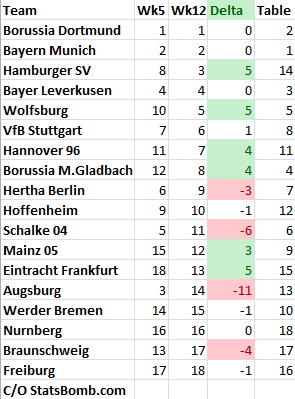 League Winner: Dortmund or Munich. That’s it. CL Spots: Leverkusen, Wolfsburg. Hamburg are too far back. Gladbach likely to fall away. Relegation: Freiburg. Braunschweig, Nurnberg. Bremen, Augsburg, and Frankfurt could still be in the mix. Movers and Shakers Wow is Bundesliga volatile. Most leagues sort themselves out quickly and you see only a couple of major movers in the next 5-6 weeks. Not in Germany. The biggest plunge of any team in Europe was made by Augsburg. I mentioned last time that their position in the league rankings was a surprise, but their plummet has been equally surprising. The model suggests their combined issues on offense and defense are costing them about an extra half goal a match, when their baseline stats suggest they should be much, much better. My guess is that this is down to errors and inferior personnel, but I haven’t watched nearly enough of them to know better. Schalke have also fallen steeply in the model rankings. They are still 6th in the league table with a goal difference of 0 and a Shot Dominance under 1. Good luck with that. Hamburg This team is basically the most confusing one in Europe in terms of where the model places them versus where they are in the league table. On September 23, they named Bert Van Maarwijk, manager of the 2010 World Cup Final with the Netherlands, as their new manager. Since BVM took over, they have gone from mid table in the model to top 3. Except they sit 14th in the table. Goal difference suggests the model is definitely seeing something that hasn’t shown up in the league table yet, but 3rd best team in Germany? Really? I am sceptical… and it’s MY MODEL! Welcome to my world (and yes, your own scepticism is duly noted). I will say there is a lot of younger talent on that team. I feel like if van Maarwijk gets their defense sorted out, they will make a strong push up the table in the next 20 matches or so. Doom Patrol Freiburg are definitely getting relegated. Nurnberg changed managers and are creeping up, so might have a chance to escape – they are basically dead level in model coefficient with Braunschweig now. There are other teams that could potentially get sucked into the vortex listed above, but these three are the most likely to finish in the bottom 3. Borussia Dortmund I’m not going to tell the master how to do things, but Klopp kinda maybe might need to rotate his kids a bit more. Despite the two tough losses last week, they are still one of the two best teams in Europe. Serie A Week 12
League Winner: Dortmund or Munich. That’s it. CL Spots: Leverkusen, Wolfsburg. Hamburg are too far back. Gladbach likely to fall away. Relegation: Freiburg. Braunschweig, Nurnberg. Bremen, Augsburg, and Frankfurt could still be in the mix. Movers and Shakers Wow is Bundesliga volatile. Most leagues sort themselves out quickly and you see only a couple of major movers in the next 5-6 weeks. Not in Germany. The biggest plunge of any team in Europe was made by Augsburg. I mentioned last time that their position in the league rankings was a surprise, but their plummet has been equally surprising. The model suggests their combined issues on offense and defense are costing them about an extra half goal a match, when their baseline stats suggest they should be much, much better. My guess is that this is down to errors and inferior personnel, but I haven’t watched nearly enough of them to know better. Schalke have also fallen steeply in the model rankings. They are still 6th in the league table with a goal difference of 0 and a Shot Dominance under 1. Good luck with that. Hamburg This team is basically the most confusing one in Europe in terms of where the model places them versus where they are in the league table. On September 23, they named Bert Van Maarwijk, manager of the 2010 World Cup Final with the Netherlands, as their new manager. Since BVM took over, they have gone from mid table in the model to top 3. Except they sit 14th in the table. Goal difference suggests the model is definitely seeing something that hasn’t shown up in the league table yet, but 3rd best team in Germany? Really? I am sceptical… and it’s MY MODEL! Welcome to my world (and yes, your own scepticism is duly noted). I will say there is a lot of younger talent on that team. I feel like if van Maarwijk gets their defense sorted out, they will make a strong push up the table in the next 20 matches or so. Doom Patrol Freiburg are definitely getting relegated. Nurnberg changed managers and are creeping up, so might have a chance to escape – they are basically dead level in model coefficient with Braunschweig now. There are other teams that could potentially get sucked into the vortex listed above, but these three are the most likely to finish in the bottom 3. Borussia Dortmund I’m not going to tell the master how to do things, but Klopp kinda maybe might need to rotate his kids a bit more. Despite the two tough losses last week, they are still one of the two best teams in Europe. Serie A Week 12 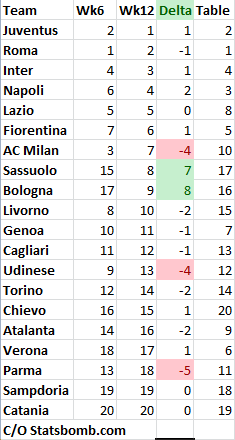 League Winner: If Roma get + stay healthy, then Roma or Juve. If not… Juve. CL Spots: Roma, Inter, Napoli, Lazio, Fiorentina. Inter to Fio is a tight cluster of teams all about the same strength. Relegation Candidates: Catania. Sampdoria. One of Parma, Atalanta, and sigh, Verona. Movers and Shakers The two biggest positive movers are Sassuolo and Bologna, whose points total is near the bottom of the league, but who the model thinks should actually finish much closer to midtable. Personally I have no opinion about these two – I’m just reporting what the math says. Napoli also improved slightly, but their coefficient isn’t close to the two elite teams in the league. I generally liked their summer purchasing, but Albiol sticks out like a sore thumb. On the downslope are AC Milan (injuries and a seemingly inevitable backlash against Allegri), Udinese, and Parma. Parma are now clustered with a group of teams that could potentially get relegated. Their shot dominance isn’t that bad, but they play in a way that leaves them very little margin for error if they ever fall behind. Doom Patrol Catania are simply not good, and the table reflects this. Don’t expect them to move off the relegation range without some crazy luck. Sampdoria look like they should be better, but they are wasteful offensively and seem strapped for talent on both sides of the ball. Verona likely are not getting relegated, but they ain’t finishing 4th either. The last relegation spot in SerieA isn’t remotely clear. The Juventus Problem Okay, so Juve have some issues at the back this season, much more so than in the past. They’ve just had moments of poor concentration leading to defensive errors, and Buffon Is God has turned into Buffon is Human. He’s 36 this season – these things happen. That said, Juve are again ridiculous. Their midfield 3 of Pirlo, Vidal, and Pogba is the best in the land and probably one of the best in the world. Llorente and Tevez have certainly improved an attack that didn’t really impress last season, and their coefficient has rocketed upward over the last six matches. Roma’s has fallen off a bit, which is expected when you lose the best player in the league this season (Totti) and Gervinho at the same time. They should still make the CL pretty easily, but they need both of those guys healthy and quickly to keep up with the Turin juggernauts. Math is Stupid Compare the model positions of Verona and Atlanta to the table positions of those two teams. Italy gives zero fucks about our silly math. --@mixedknuts
League Winner: If Roma get + stay healthy, then Roma or Juve. If not… Juve. CL Spots: Roma, Inter, Napoli, Lazio, Fiorentina. Inter to Fio is a tight cluster of teams all about the same strength. Relegation Candidates: Catania. Sampdoria. One of Parma, Atalanta, and sigh, Verona. Movers and Shakers The two biggest positive movers are Sassuolo and Bologna, whose points total is near the bottom of the league, but who the model thinks should actually finish much closer to midtable. Personally I have no opinion about these two – I’m just reporting what the math says. Napoli also improved slightly, but their coefficient isn’t close to the two elite teams in the league. I generally liked their summer purchasing, but Albiol sticks out like a sore thumb. On the downslope are AC Milan (injuries and a seemingly inevitable backlash against Allegri), Udinese, and Parma. Parma are now clustered with a group of teams that could potentially get relegated. Their shot dominance isn’t that bad, but they play in a way that leaves them very little margin for error if they ever fall behind. Doom Patrol Catania are simply not good, and the table reflects this. Don’t expect them to move off the relegation range without some crazy luck. Sampdoria look like they should be better, but they are wasteful offensively and seem strapped for talent on both sides of the ball. Verona likely are not getting relegated, but they ain’t finishing 4th either. The last relegation spot in SerieA isn’t remotely clear. The Juventus Problem Okay, so Juve have some issues at the back this season, much more so than in the past. They’ve just had moments of poor concentration leading to defensive errors, and Buffon Is God has turned into Buffon is Human. He’s 36 this season – these things happen. That said, Juve are again ridiculous. Their midfield 3 of Pirlo, Vidal, and Pogba is the best in the land and probably one of the best in the world. Llorente and Tevez have certainly improved an attack that didn’t really impress last season, and their coefficient has rocketed upward over the last six matches. Roma’s has fallen off a bit, which is expected when you lose the best player in the league this season (Totti) and Gervinho at the same time. They should still make the CL pretty easily, but they need both of those guys healthy and quickly to keep up with the Turin juggernauts. Math is Stupid Compare the model positions of Verona and Atlanta to the table positions of those two teams. Italy gives zero fucks about our silly math. --@mixedknuts
StatsBomb MythBusting: Christian Eriksen vs. Newcastle
This past weekend in the Premier League was a crazy one, and no single game was crazier than Spurs vs. Newcastle*. Newcastle looked dangerous early on, and actually took the lead in the 13th minute on the back of a Paulinho mistake, sparked off some surprise pressing from the Geordie side. What followed were 77 minutes plus stoppage time of hell for the Newcastle defense.
Final score: Tottenham Hotspur 0 – Newcastle 1
* Those of you in Swansea and West Bromwich wanting to make cases about the referee robberies in your games should make contact with the appropriate Premier League authorities as soon as possible.
I mentioned after the game wrapped that Tim Krul was out of his mind good (14 saves in a match almost never happens), and also that Christian Eriksen was really tremendous for the home side.
In 77 minutes against an entrenched defense, Eriksen had 9 key passes, 3 shots, 3 shots on target, 71% passing completion. That’s a damned fine day for an attacking midfielder. The passing percentage is a bit low, but the rest of it… impressive. He didn’t do a ton of defensive work (1 tackle, 1 Int, 1 Aerial Duel won), but Spurs have an entire team built for that. Defensive work is not his job. Eriksen’s job is to find his teammates with passes that they can turn into shots, and boy did he do that.
Thus I was a little surprised at the reaction of Spurs fans to my Eriksen opinion. The abuse that I got from Spurs fans was loud. And kinda angry, really. A lot of these aren’t from dumb guys – one is from one of the Spurs writers I respect the most - but boy were they hot about the loss.
Visually, this is what Eriksen's performance looked like from the FourFourTwo StatsZone:
So I said Eriksen was awesome, and other people said…
“Outstanding?! He was one of our worst players. Missed a sitter, bad set pieces, lots of wasted possession.”
“[Eriksen] was ineffective and inefficient.”
“You don’t know what you are talking about. You’d have a different perspective if you watched him in the stadium. Nobody in the stadium thought he was good.”
“[Townsend] was good – at least he was trying his heart out.”
“His set piece taking was awful. Went into hiding. Fit the stereotype of the scouting reports.”
“He’s made a MASSIVE jump in league standard.”
I will note I did watch the game in detail while it was on. I actually watch a lot of Spurs games these days, partly because I like some of the players, partly because I like the AVB system, but mostly because I really need to know why they aren’t scoring more goals for work.
I could be wrong about what I saw. Obviously I have a bias toward using data to examining football from the perspective of data, but what if Eriksen’s performance really wasn’t that special? I decided to look at how often a performance like CE’s appear, and also at some more contextual stats to better examine what happened on Sunday. I also rewatched the video with a focus on what Eriksen was doing.
Time for some mythbustin’!
Passing is Misunderstood
One of the first pieces I wrote about football stats involved looking at assists as a key indicator for finding good players. Somewhat to my surprise, I discovered the ability to create high numbers of assists at a young age typically translates to stardom.
I used assists in that analysis because key pass information wasn’t publically available for earlier seasons, but assists have been tracked in certain leagues since at least 2003. However, key passes are a part of the process that leads to assists, and occur more frequently, so when possible, I try to use that information instead.
Why? It has to do with separating outcomes from processes.
Example: A player passes the ball to an open attacker at the 18 yard box, who then shoots, and kicks the ball into the upper deck.
The outcome there is bad (missed shot). The process, however (finding the open man 18 yards out for a shot), is good.
Is the missed shot the fault of the passer or the shooter? That type of analysis is difficult, but let’s just say that most of the fault for the miss probably lies with the shooter. If that shooter is particularly bad at getting shots on target, regardless of who passes to him, then he’ll drag down the assist stats of the passer as well. However, key passes will still get registered.
That’s why key passes are interesting to track, and high levels of KP usually translate to high levels of goals/assists.
Before I get too far ahead of myself, we probably need a definition.
What is a key pass? Opta defines it as:
The final pass or pass-cum-shot leading to the recipient of the ball having an attempt at goal without scoring.
Key passes are correlated to assists, which are goals resulting from a pass, and are a fairly strong measure of whether a player is a good offensive passer.
The top 5 in EPL for key passes last year were David Silva, Baines, Suarez, Mata, and Steven Gerrard. The year before was Mata, Silva, Modric, Nasri, RVP, and Valencia (13 assists for United that season in 22 starts!). It’s an imperfect, but damned useful stat.
So key passes matter. In fact, they usually tend to indicate players who not only create chances, but create +EV ones. I would far prefer to have a bunch of guys on my team who pass well enough that they create shots with scoring probabilities of 30-40% (open looks in the box, 1v1s with the keeper) vs. the 10% average.
Championship winning teams are built on this principle. And yet teams still don’t seem to value great passers enough. Real Madrid sold Mesut Ozil, the best creator in Europe over the last five seasons. Goal scorers get all the money and the attention.
They also get the adoration of fans.
Passers? Meh.
How Rare Was Eriksen’s 9 Key Pass performance?
I wanted to look at this because maybe this type of performance happens all the time. I may have found it impressive, but if it’s a common occurrence, then we can rule out my impression and just write it off as something any decent footballer can do.
I only have access to a shortened data set on this one (last year plus this year), but out of more than 1800 matches played in the big 5 leagues last season, there were fifteen times where a player had nine or more KP. Players who produced those performances included: Pirlo, Ozil, Diamanti (who also had 14 shots in the same match, one of the most absurd statistical performances I have ever seen), Boudebouz x 2, Obraniak, Farfan, Diego x 2, Tobias Werner (who?), Valeron, Susaeta, Rakitic, Jose Antonio Reyes, and Koke.
There has also been one 9+ KP game this season, produced by the ageless Francesco Totti.
So 16 total instances in more than 2000 matches. That’s less than 1%. It’s fair to say that’s rare.
“He’s made a MASSIVE jump in league standard.”
This is true, and I'm actually not certain how big the jump is. Is Eredivisie 60% as good as the Premier League? 70% I have no idea, really.
However, not only is a 9+ KP performance rare, it hasn’t happened at all in England either this season or last. That’s nearly 500 matches without one.
I checked with Duncan Alexander at Opta, and he said the last person to do it was Leighton Baines in September 2011!
So we're actually looking at like 2 in 800 matches.
Eriksen made a massive jump in league standard…
…and still hung one of the better offensive passing performances in recent league history on a Newcastle team that is actually pretty good.
Clearly, he’s shit.
Not All Key Passes Are Alike. Also, 71% Passing Success??!
Both of these are fair points. All KPs are not alike.
Some create shots that are practically worthless (like almost any ball delivered to Andros Townsend).
Others create shots that are almost goals in and of themselves. Still, Eriksen created nine of them, including a couple of peaches in a free header from a corner that was off the bar and the exquisite layoff to Paulinho in the center of the box.
Eriksen also had a set piece delivery directly to Soldado’s head that resulted in a shot on target that Krul made a good save on.
Now 71% passing isn’t very good, but it’s something that I thought was strange too. Eriksen is normally very clean with the ball, but passing through a stacked defense for the entire match is hard.
Then I dug into the numbers and noticed 13 crosses in the match. Crosses are usually completed at a 20% clip. Eriksen’s non-cross completion was 88%, but he was 2/13 on crosses.
Edit: Dan Kennett points out below in a comment that passing stats already have crosses removed, which I did not know. Read his point below for more illumination.
Check out this old image from Gabe Dejardins about expected completion rates for passes based on location of the target.
Assume for a second that Soldado was generally in the blue spots and it gets easier to understand.
Eriksen also had three shots in the match and three shots on target (again, very good).
Krul managed to save all three, just like he did with the 11 shots on target from Eriksen’s teammate. Sure, Spurs players made some of them too easy for him, but in general Krul played like an octopus with keeper gloves on.
“[Eriksen] went into hiding, fitting with the stereotype of the scouting reports.”
Really?
Dude had 81 touches, or 14 more than any other Spurs offensive player.
He was also only dispossessed one time. Townsend had 4 in a full match, Sigurdsson had 4 in 69 minutes.
This statement is just silly.
“[Townsend] was good – at least he was trying his heart out.”
Andros Townsend has one fluke, completely-by-accident goal from 45 shots this season!
His average shot distance is 26 yards!
He has 0 assists in 10 games!
Get. The fuck. Out.
Townsend’s performance so far this season is exactly what Shakespeare was thinking of when he wrote, “Full of sound and fury. Signifying nothing.”
Okay fine… I’ll come clean.
I actually thought Andros was decent on Sunday.
He had some good lateral passes to setup dangerous shots and his shooting was better than it has been this season.
Let’s not pretend he deserves to be in the lineup more than Lamela though, okay?
This Was Spurs Best Offensive Performance of the Season
And Eriksen was all over it.
Spurs had one match last season with 14 shots on target, the 1-0 at home against Sunderland on the final day of the season (which included a red card). They also had 13 as part of a 3-2 win at West Ham. Sunday they produced 31 shots, 14 on target, and got beat 0-1.
I’ve looked at a couple of different models and they thought the score probably should have been 3 or 4-1 for Spurs. Shit happens.
Spurs have only scored 6 open play goals in 11 matches, which is dreadful and is likely not the result of just being unlucky. AVB has frequently sold out on defense in personnel selections so far this season, and it’s reflected by that goal return. On Sunday though, the team had more balance, and they were outstanding offensively against a Newcastle team who are actually pretty good.
Conclusion
Outcome: Spurs lost 0-1 at home to Newcastle.
Process: They had 31 shots and 14 shots on target. Christian Eriksen did something that hasn’t been done in the Premier League in at least 500 matches. Spurs lost, but they were actually really good.
If Spurs play like this in future games, they are going to win a lot of them. More performances like this will definitely leave them in contention for a Champions' League spot. But Sunday's performance doesn’t happen without the allegedly inefficient and ineffective Eriksen. His passing was incisive. He consistently made his teammates look better. And his use of space is extremely important for a Spurs team that too often makes themselves easy for opponents to mark.
This might be controversial, but based on the rarity of that type of performance and how he's performed over his career, Christian Eriksen is quite possibly one of the best attacking passers in the Premier League already. Who somehow has only started league 5 matches so far this season.
Sigh.
If AVB ever gets his lineup selections right - which includes bringing Adebayor back from Siberia - this team could be almost unstoppable.
Bonus Stat For Those Who Made It This Far
In the list above where I noted guys who had 9+ KP games, I actually left one out. There was one more guy who produced a feat like that last season in the big 5. Spurs actually already own him.
His name?
Erik Fucking Lamela.
6 open play goals in 11 matches! Lamela can’t get on the pitch in a Premier League game!
*headdesk*
On the Block - Early Season NBA Trade Assets
Now is the time of the season when reality is setting in. Those miraculous 3-0 starts by teams projected to be in the lottery have turned into more reasonable 4-4 openings, and the better teams have started winning more games than the bad ones. But with reality arriving, so too comes the parts of reality that team owners and general managers didn’t want to admit.
Their team that they boldly thought of as a “contender” is actually pretty mediocre.
They need to make a trade.
‘Oh god. Who’s out there? Can we give up any organs we’re not using all that often? Everyone’s gonna think that guy we picked up in the second round and shooting 39% is worth something… right?’
Such is the dilemma faced by executives across the nation. I don’t envy them. Okay, fine, I do envy them a lot, but their job is still tough, aside from the being in an air-conditioned office and making hundreds of thousands of dollars to decide the fate of athletes… let’s move on.
The Most Important Trade Assets: Rudy Gay
Who?
Why is he important?
The Toronto Raptors are a fantastic team to ask a fan about to find out their perspective on the game. If you ask a casual fan, they will maybe be able to tell you that either OJ Mayo or Rudy Gay plays for them (Mayo actually plays for Milwaukee, but I get the two of them confused all the time, it’s not a big deal). If you ask a more serious fan, they’ll tell you that they finally have a good player in Rudy Gay to get them buckets at the end of games. If you ask an analytics-oriented person, they’ll roll their eyes derisively at the previous fan, and inform you that there’s some dude named Amir Johnson who plays basketball.
The hatred that the analytics-minded have for Rudy Gay has crossed over slightly to the mainstream, in that people will preface their praise with “stat geeks hate him, but…”
First, the good news: he’s an above-average defender and rebounder for a small forward.
That's it. That's all of the good news.
The bad news is that the offense - the entire reason teams want him - is actually really bad. He takes a ton of shots, and is not good at taking shots. With point guards, this can be somewhat excused, because their driving and ballhandling opens up shots for other people, but Rudy Gay is a certified non-passer. He hates, hates, hates passing, and on this Raptors team with fellow shot-attempter DeRozan, he’s probably not getting it back if he does.
He is a jump shooter that should not shoot jump shots. He is an athletic finisher that shoots barely over 50% from within 8ft (per nba.com/stats), and so far this year he’s down to 36% there.
So… why is he important? Because the Raptors secretly have a great three-man core in Kyle Lowry, Amir Johnson, and Jonas Valanciunas. Getting rid of Gay’s empty possessions will improve them immensely, and hopefully do something about Toronto’s dead-last pace and woeful passing. Tonight’s game featured 114 field goals attempted by the Raptors, and ten assists. That shouldn’t happen, ever, and Rudy Gay’s fingerprints are all over it in the bricks he put up.
Who wants him?
The good news for My Hero Masai Ujiri is that not everyone agrees with the above assessment. Some share the optimism that his predecessor had when he acquired Gay, hoping that giving their team “a scorer” would make the offense better. This did not work in Toronto, and it will not work outside it, either.
Someone will trade for Gay, and probably give up good players to do it. Look for the usual suspects of suspect decision-making, especially among underperforming teams. If the Knicks trade for Gay, I will nearly explode with disaster-awaiting delight. However, that’s probably unlikely, since if the Knicks hear Masai Ujiri calling them again, they should just slam the phone down at this point.
Omer Asik
Who?
Why is he important?
Last year, he doubled his career average minutes, going from the best backup center in the league for the Bulls into a league-renowned starting center for the Rockets. He was the same player, of course, and his production despite the extra minutes load vindicated advanced stats people who projected him as a great starter. When he was on the floor for the Rockets, they had a top-ten defense (team DRTG of 104.2, vs a league average of 105.9, per basketball-reference). When he was on the bench, there were few worse defensive teams. It doesn’t get much night-and-day different than that. If offensive and defensive impact were weighted equally in the minds of fans, he would have been an All-Star, but basketball doesn’t work that way.
Fans don’t generally see the subtle movements defenders make to guard pick-and-rolls, or the way that a seven-footer will come out of the paint to guard a nimble guard, or how certain defensive bigs can time their jumps perfectly to make at-rim shot attempts seem impossible without fouling. What they see, in Asik’s case, are the hilariously fumbled passes, the inability to bounce the ball more than once (if that), and the horrendous free throw shooting if he does hang onto the ball.
The good news for Asik is that the game itself doesn’t much care if you produce in an aesthetically appealing way. Asik does his defense-and-rebounding thing, and he’s one of the best in the league at it. The Rockets, amongst other teams, recognize this, and paid him a starting salary for it. The truth is, he’s just too good to serve as a backup; an elite player playing under 25 minutes is just an inefficient use of resources.
The Rockets have also tried some ‘twin towers’ lineups with both him and Dwight Howard playing at the same time, but this is not a long-term solution. Combinations of big men like Sampson-Olajuwan, Duncan-Robinson, and Gasol-Bynum weren’t just throwing two centers out there and having them both act like centers; they worked because the former player in those pairs had an offensive game that was best slightly further from the basket, in the midrange rather than lounging around the basket for dunks. Neither Asik nor Howard can reliably make free throws, so god knows defenses aren’t going to respect them when they catch the ball at the free throw line during a play. And on defense, they’ll certainly be good together (they might even be fantastic), but neither of them need the added safety of another big defender. Howard spent his time anchoring an elite defense that was him and four guys that did not play defense even a little bit. He honed his craft next to Ryan Anderson; he doesn’t need Asik there.
Who wants him?
About half the teams in the league have a center they’re somewhat confident in going forward, and the other half would love to have an elite defensive big starting for them. I admit that I heard this one from Bill Simmons, but Asik going to New Orleans in exchange for Ryan Anderson almost makes too much sense for it to possibly happen. There will be some competition here, though, and I expect that a lot of teams are making calls about him.
Ryan Anderson
Who?
Why is he important?
The common criticism of Anderson is that he “can’t create his own shot.” My response is a simple “who gives a shit?” He launches about eight three-pointers per 36 minutes, making just under 40% of them. He’s in an elite group of players that are extremely good at shooting threes while still posting above-average usage rates, meaning they aren’t just hanging out waiting for something to happen, they are actively taking shots.
Unlike those low-usage players, Anderson has a nifty fake-and-drive maneuver if the defense closes too quickly for a good shot. Somehow, he manages to add extremely good offensive rebounding on top of that. Along with the previously-mentioned Amir Johnson and Asik, he’s a classic adored-by-advanced-stats-followers guy. However good you think he was at the end of his stay in Orlando, there are stats saying he was better than that, even ones that show him to be a top-ten player on the offensive side of the court.
New Orleans just isn’t the place for him, though. He’s playing a sixth man role there, which is bad for multiple reasons: he’s not the classic versatile sixth man, as he is very definitely a stretch four, and putting him at small forward will get him embarrassed defensively even more than usual. There’s no getting around it: his defense is bad, and always has been. New Orleans was the first time that his bad defense had, in terms of plus/minus, actually outweighed his offensive contributions. He needs to play next to a rock-solid defensive center, not a developing-but-wiry power forward like Anthony Davis. The two of them on the court together were an unmitigated defensive disaster, and neither of those excellent players deserves to be stuck with someone that brings out the worst qualities in their skillsets.
Who wants him?
As three-point shooting creeps up in importance year after year, guys like Ryan Anderson become more and more valuable. Anyone that doesn’t have an elite power forward (and make no mistake, that is what Anthony Davis is) shouldn’t turn him down if they could get him, but particularly teams with issues shooting three-pointers like the Bulls and Grizzlies should make an offer. Even if a team has shooters at both guard spots and small forward, taking more three-pointers is just good strategy, and leads to more open looks for the other shooters the better-spaced the floor is.
Goran Dragic
Who?
Why is he important?
Like the two players above, this is a starting-caliber player who’s playing less than 30mpg due to the needs of the franchise. The Suns are trying to rebuild around Eric Bledsoe and their Scrooge McDuck-sized pile of draft picks, and Dragic is a quality point guard gumming up the works.
The above paragraph is the same as what I would have written before the season, so now let me admit: I have no idea what’s going on with the Suns. They were supposed to be near-historically terrible, with probably eight players I could not pick out of a police lineup, yet they somehow are, as of this writing, 5-2. I am going to rain on Phoenix’s desert and say that this will not hold up; that no, Eric Bledsoe and Markieff Morris did not just become two of the best players in the NBA, that their 60% shooting on two-pointers will come down to earth (and Bledsoe’s Hardenesque foul drawing can probably come down a bit with it), and that this bunch of randoms will probably not continue to have the 6th-best defense in the league.
Even in the midst of this mystifying run, Dragic isn’t having the best year. He is not a shooter, he is not a slasher or an off-the-ball-cut-maker, he is a point guard who runs pick-and-roll and finds open players with the ball in his hands. Bledsoe, on the other hand, has (as noted above) been playing wonderfully while Dragic was injured. To further Bledsoe’s development, and to continue their strategy of trading everyone not currently entombed for draft picks, they’ll almost certainly ship out Dragic for more picks and maybe some prospect PG to back up Bledsoe instead.
Who wants him?
Dragic is a good starting point guard, but the NBA has become an increasingly point-guard driven league, and merely being good will leave you unwanted by a shockingly large number of teams. (Note to prospective players: practice those wing skills, we’re in short supply of good ones at the moment.) I doubt that anyone will want to pay him 7.5m to play 10mpg in the playoffs, but if none of the teams without a real PG are interested, it might not be terrible for him to go to a team like the Warriors with an injury-prone PG to push them up a few places during the regular season. I hear the Bulls might be looking for someone new.
Derrick Rose
Errata to the piece on Masai Ujiri: I left out something very important about JaVale McGee that really affects my opinion of that trade. McGee suffers from chronic asthma, and the altitude in Denver pretty obviously bothers him. His home/away splits last year are like nothing I’ve ever seen: his TS% was 62.9% on the road, compared with 53.8% at home, and his offensive rebounding was better by about 20%. He even played several more minutes per game on the road than at home. Basically, JaVale McGee cannot be a professional basketball player in Denver, and I hope that Denver’s management realizes this and trades him. Every time I saw JaVale wheezing on the sidelines, I felt genuinely uncomfortable.
